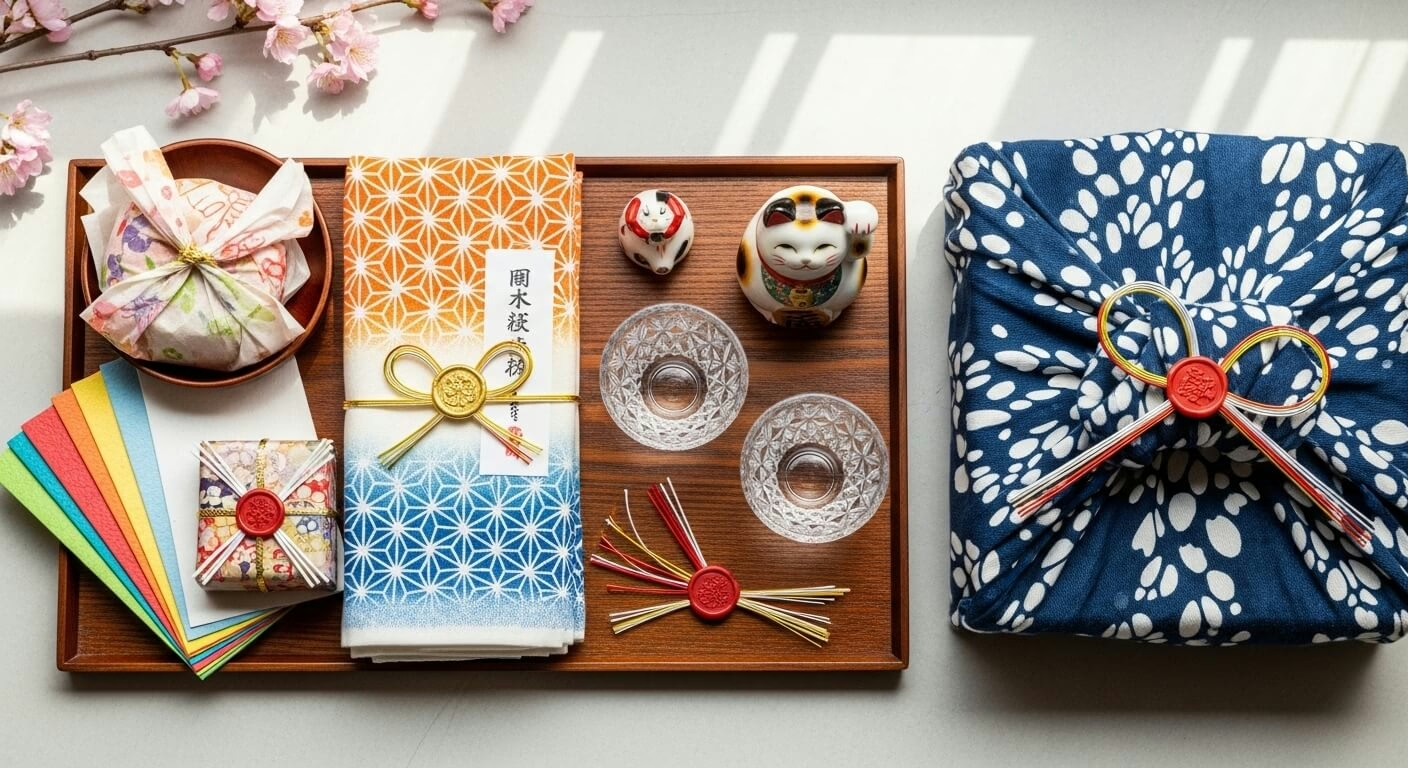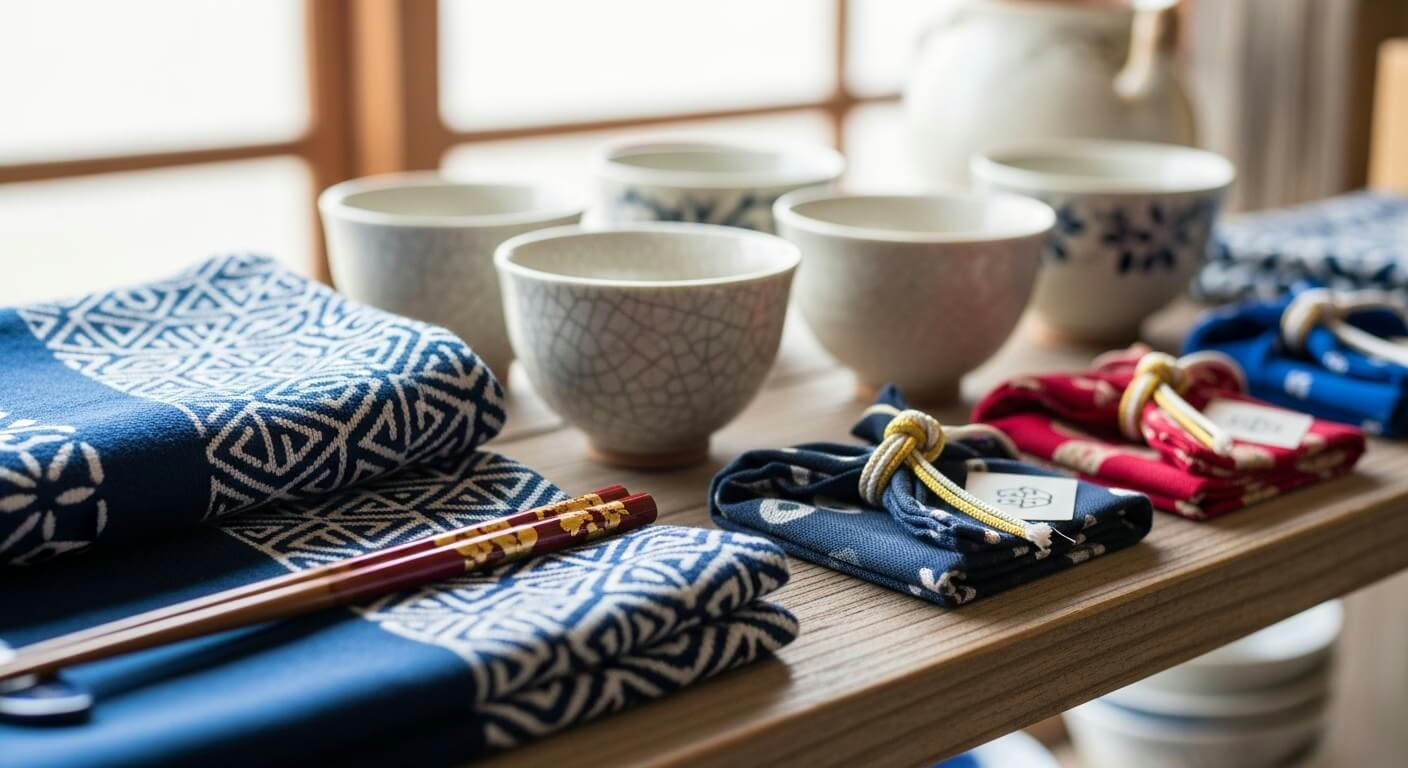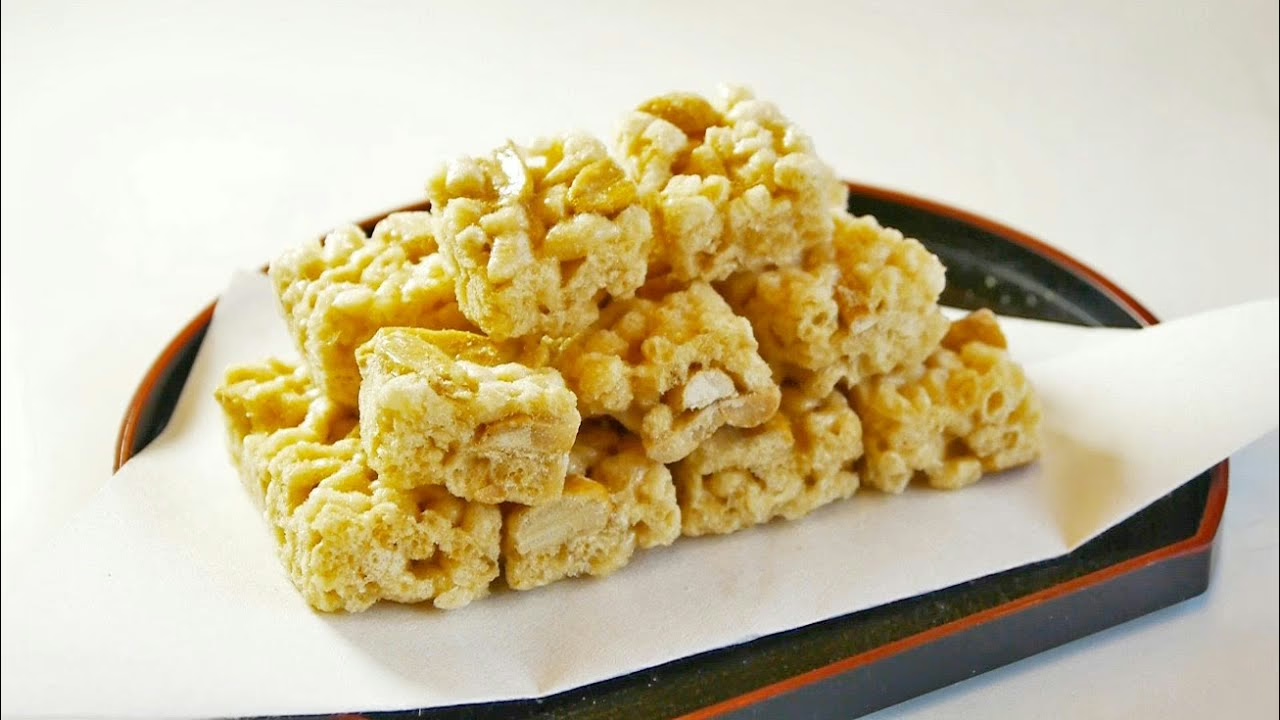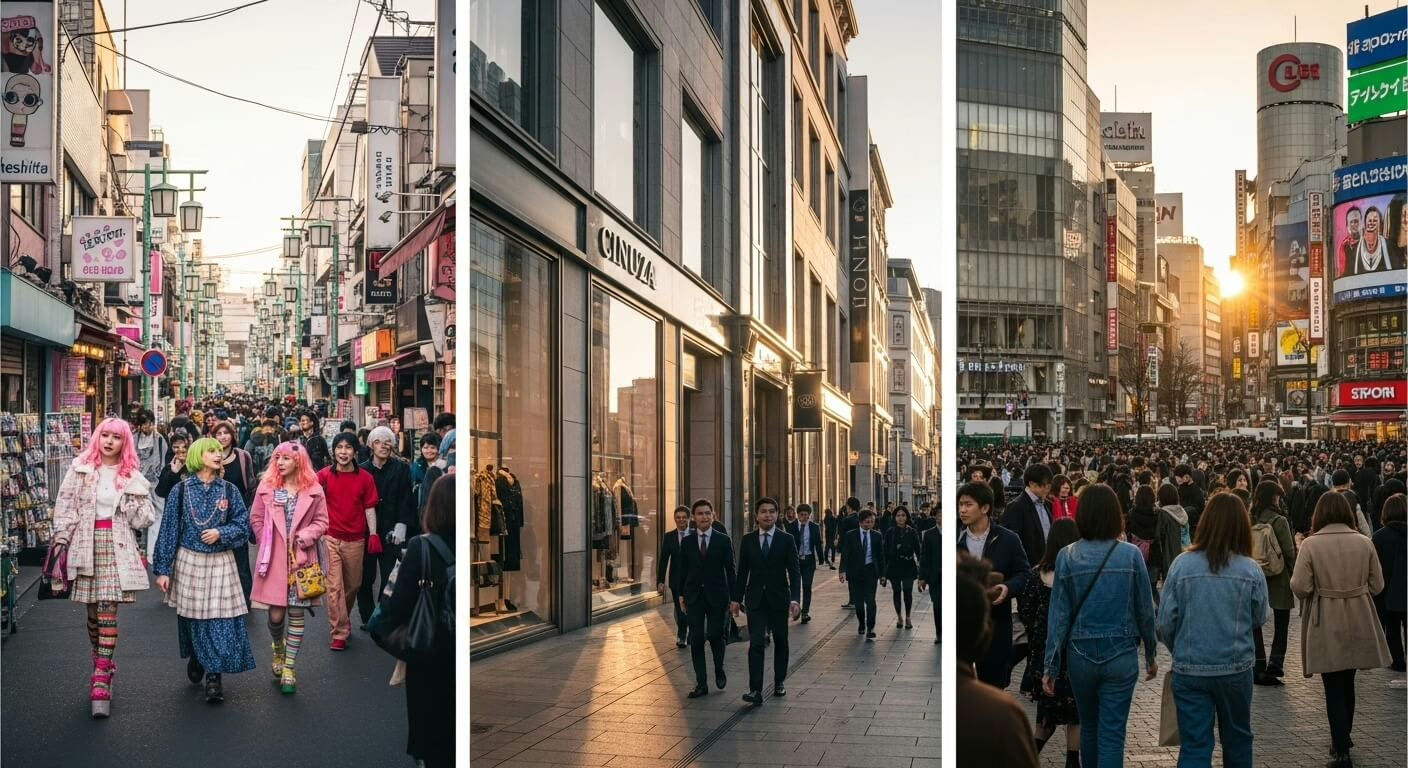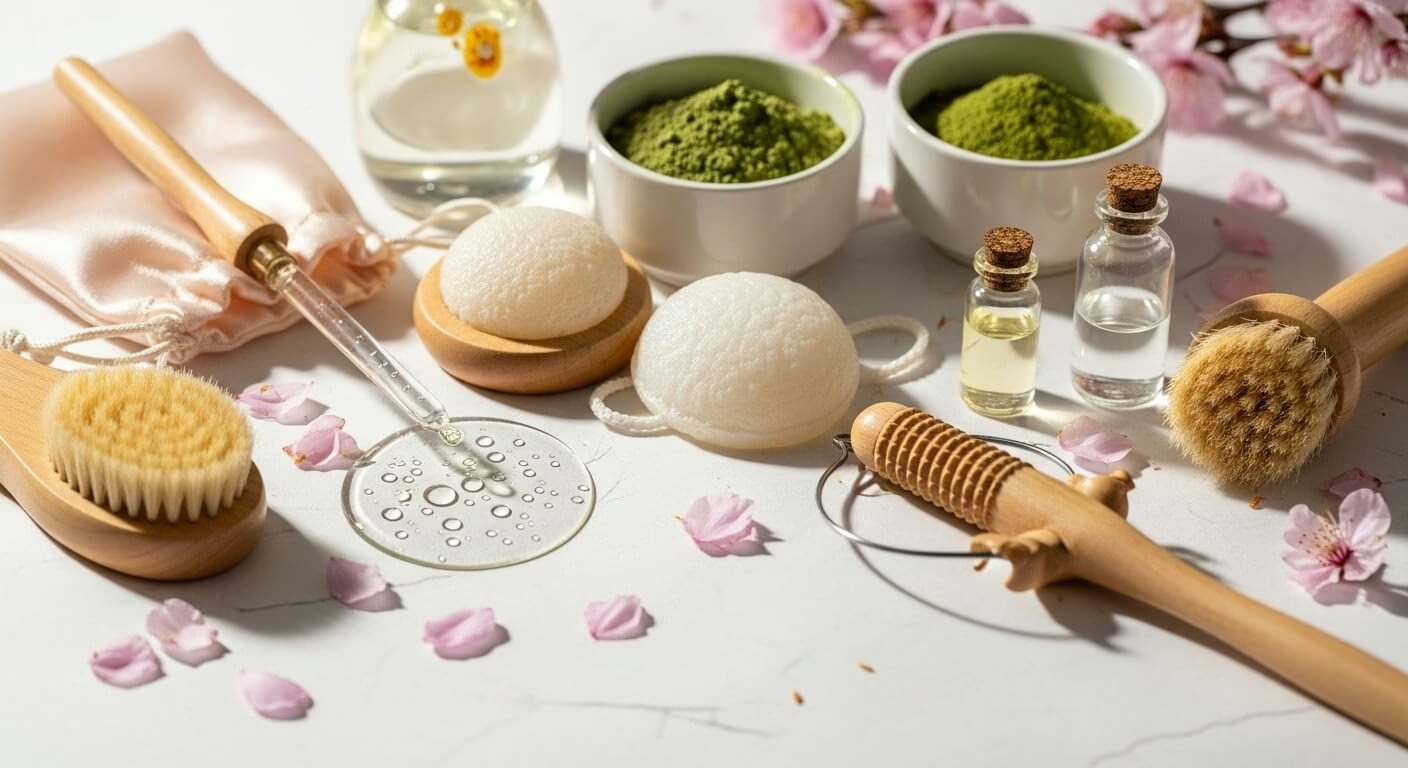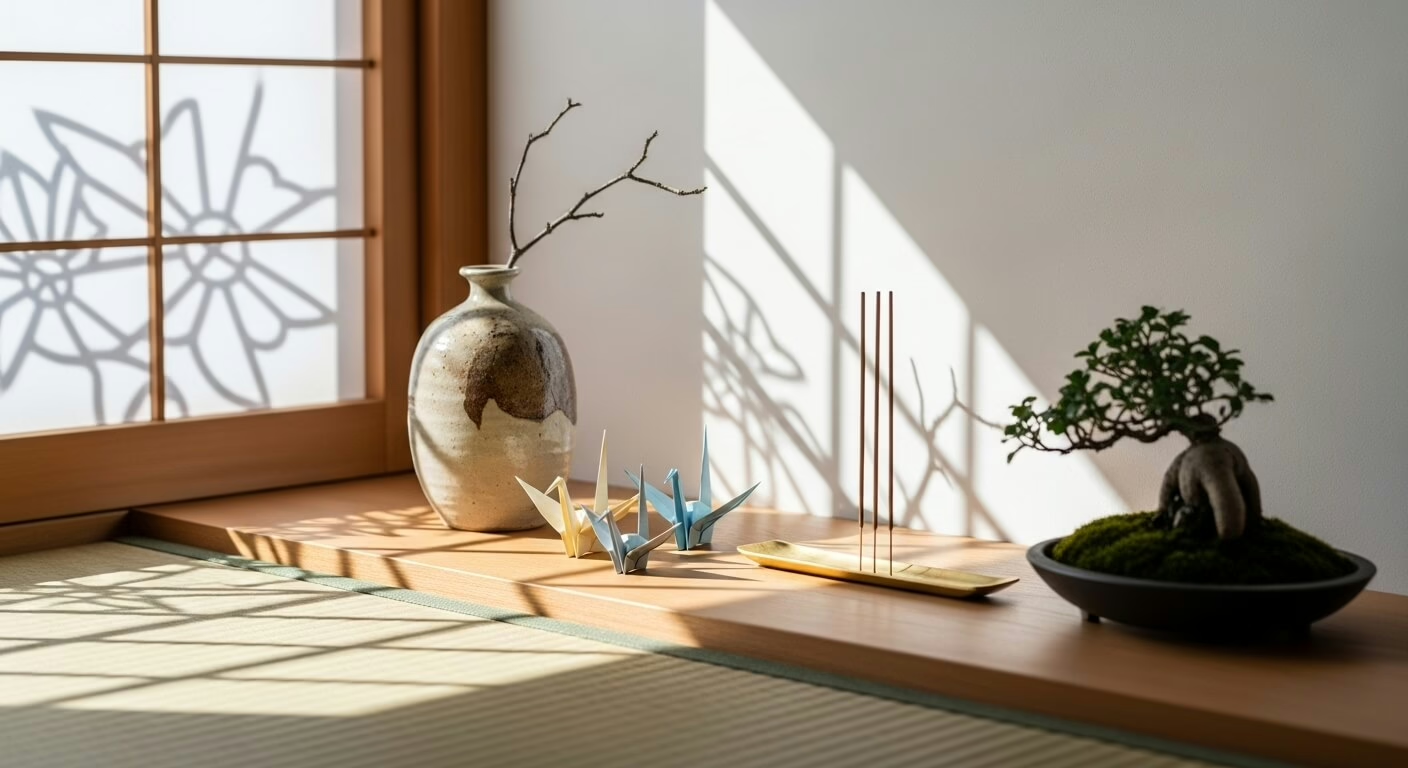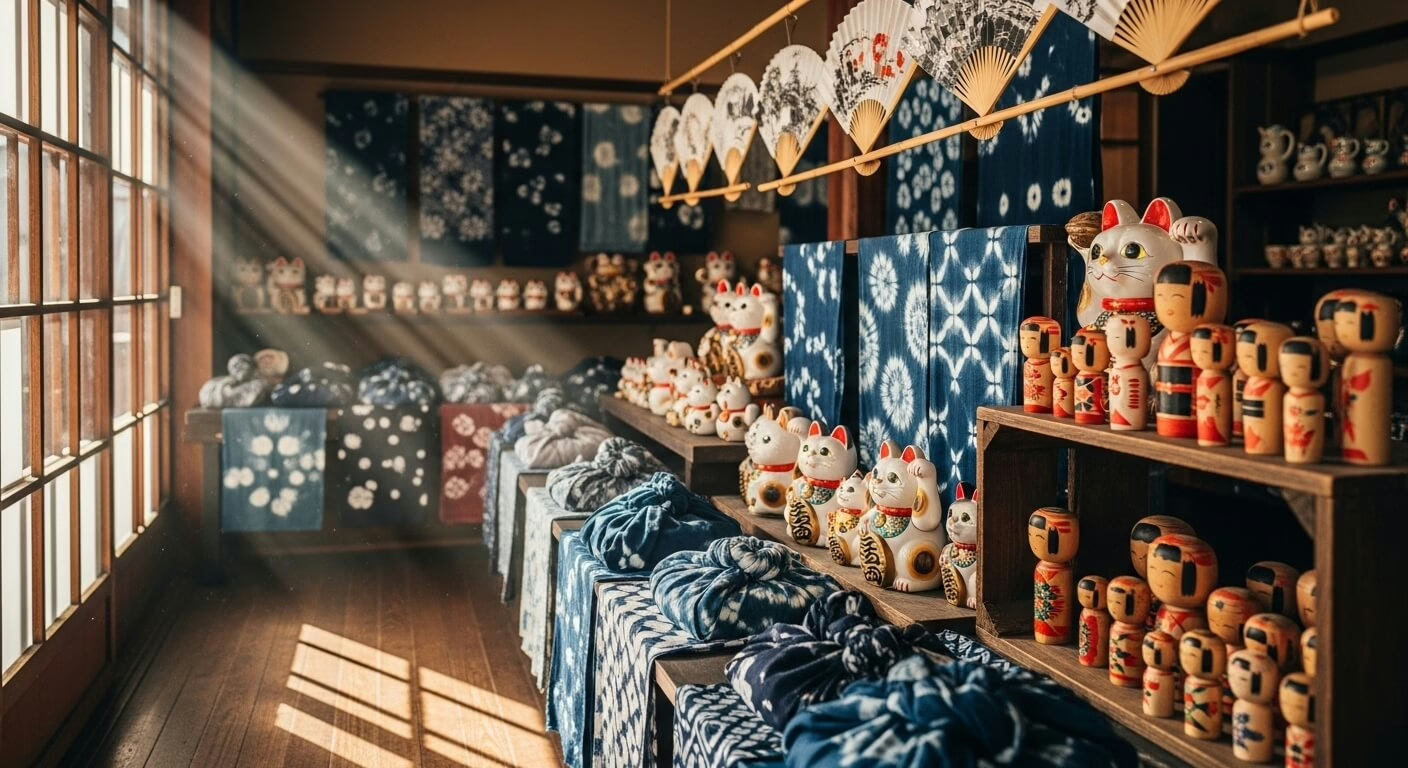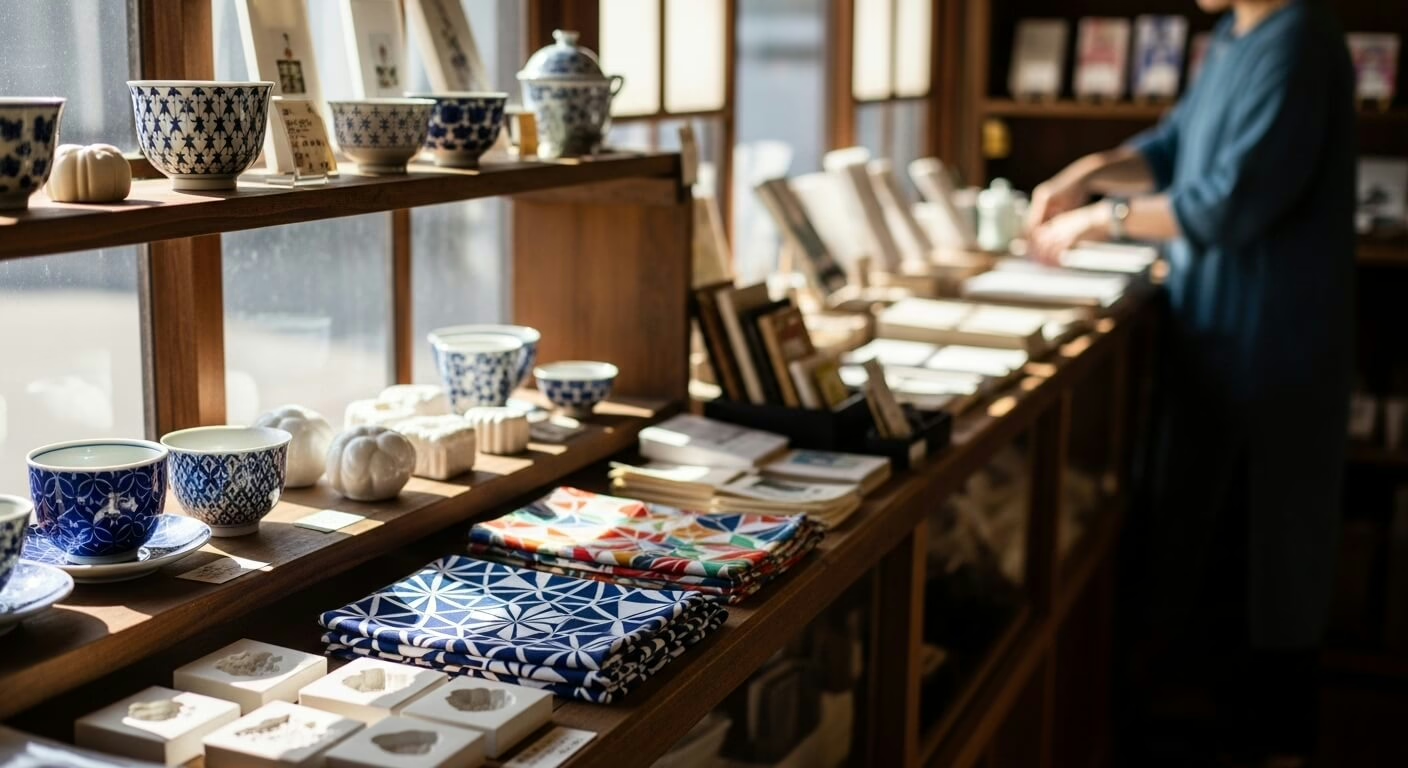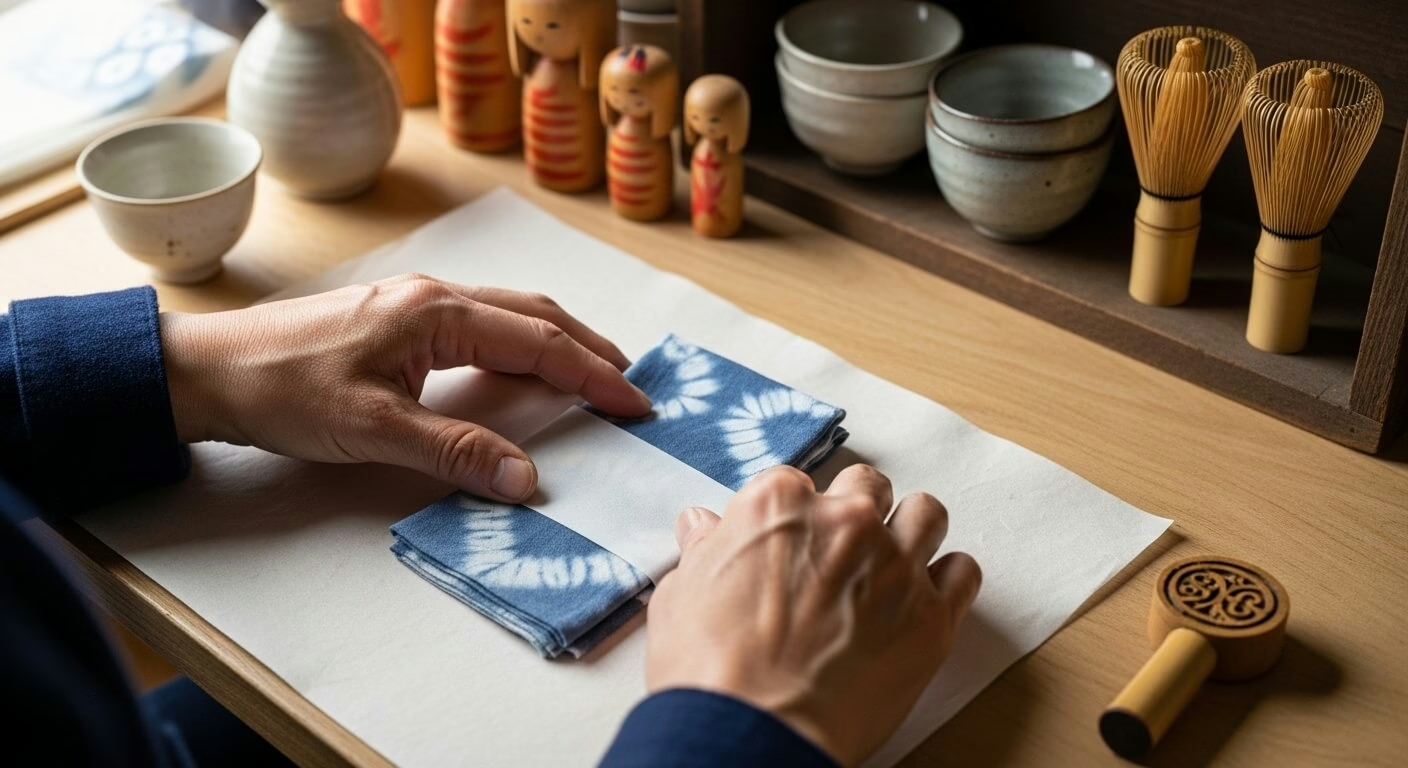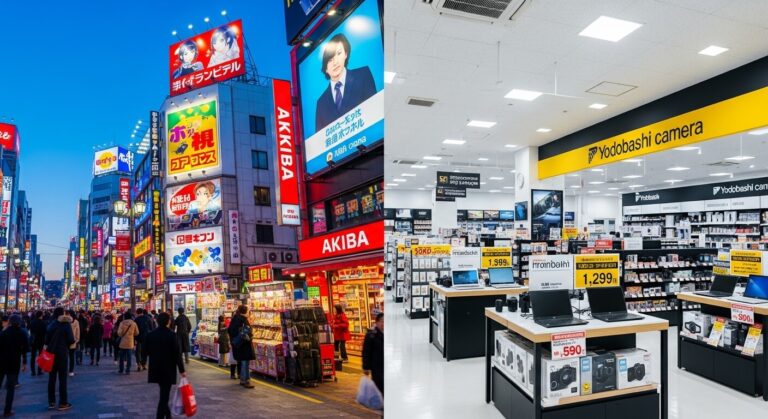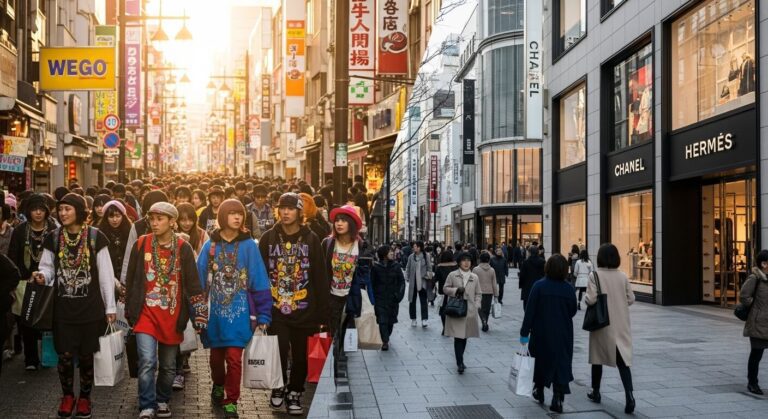Tokyo Souvenir Guide: Unique Gifts Beyond Tourist Traps
Authentic Tokyo Gifts: A Local’s Guide to Memorable Souvenirs – Tokyo’s most memorable souvenirs live beyond airport gift shops in artisan workshops and heritage stores throughout Asakusa, Yanaka, and Ginza.
Smart travelers seek hand-cut Edo Kiriko glassware, traditional tenugui towels with contemporary designs, and artisanal confections from shops like Kaminari Okoshi (established 1795) rather than mass-produced Tokyo Banana.
Authentic finds include single-origin gyokuro tea, handcrafted soaps using sake lees and rice bran, plus Tokyo-exclusive masking tapes from brands like mt featuring cherry blossoms and vintage train maps.
The true treasures combine centuries-old craftsmanship with modern utility, transforming simple purchases into conversation-starting heirlooms that reveal deeper layers of Japanese culture.
Key Highlights
Hide- Authentic crafts like Edo Kiriko glassware and hand-carved kokeshi dolls offer meaningful souvenirs with artisan signatures and quality markers.
- Regional confections such as Kaminari Okoshi and Shiseido Parlour biscuits provide historically significant alternatives to mass-market treats.
- Traditional textiles including tenugui towels and noren curtains combine functional utility with artistic design at affordable prices.
- Artisanal teas like Gyokuro and first flush Sencha surpass generic tea bags with complex flavors and single-origin authenticity.
- Japanese beauty products featuring sake extracts and fermentation-based ingredients blend ancient botanical traditions with modern biotech innovation.
What Makes a Tokyo Souvenir Worth Bringing Home?
When travelers stand in that gift shop wondering if they should grab another keychain or splurge on handmade ceramics, the decision ultimately comes down to three essential factors that separate memorable keepsakes from regrettable impulse buys.
Tokyo Trip Add-Ons
Equip yourself for the ultimate Tokyo adventure with the following add-ons, curated just for you.
The real magic happens when shoppers can spot the difference between authentic Japanese craftsmanship and tourist trap knockoffs, understand what price points actually reflect quality versus hype, and—perhaps most practically—figure out how to get their treasures home without turning their suitcase into a fragile disaster zone.
- Tokyo With Kids: Family-Friendly Activities & Tips
- Tokyo New Year’s Guide: Shrine Visits & Holiday Traditions
- Tokyo Healthcare for Travelers: Hospitals & Travel Insurance
- Tokyo Valentine’s Day: Local Customs & Romantic Spots
- Tokyo Power Outlets and Voltage: Smart Electronics Tips for Travelers
- Tokyo Free Museum Days: When to Visit Without Paying
These considerations transform souvenir shopping from a frantic last-minute scramble into a strategic hunt for pieces that’ll spark joy every time they catch your eye back home!
Authentic Craftsmanship vs Mass-Produced Merchandise
As travelers browse Tokyo’s endless gift shops, they face a crucial question that separates meaningful mementos from forgettable trinkets: should they invest in handcrafted artisan pieces or grab convenient mass-produced goods?
The answer shapes not just your suitcase, but your entire Tokyo story!
Authentic craftsmanship offers three irreplaceable advantages:
- Each piece carries the maker’s soul – whether it’s handmade jewelry from Asakusa’s workshops or vintage posters from Nakano Broadway’s treasure-filled stalls.
- You’re supporting independent artisans who’ve perfected their craft over decades, preserving traditions that mass production threatens to erase.
- Your souvenir becomes a genuine conversation starter instead of something gathering dust alongside identical airport-bought knickknacks.
Sure, mass-produced merchandise costs less upfront, but authentic craftsmanship delivers lasting value that transcends price tags.
Tokyo Souvenirs Price Points That Actually Make Sense
Three distinct price tiers define Tokyo’s souvenir landscape, and understanding them transforms shopping from random spending into strategic treasure-hunting.
The under-1000-yen bracket delivers maximum impact—think artisan Kit Kats, hand-stamped tenugui towels, and affordable jewelry from Shimokitazawa’s vintage boutiques that rival expensive department store pieces.
Mid-range purchases (2000-5000 yen) unlock genuine craftsmanship: ceramic cups from Kappabashi, budget fashion treasures in Harajuku’s backstreets, or exquisite washi paper that’ll outlast your grandchildren.
Premium souvenirs exceeding 10,000 yen require serious consideration, but items like antique kimono accessories or master-crafted knives justify their pricing through irreplaceable quality.
Smart shoppers balance all three categories, building collections that celebrate Tokyo’s diversity without depleting travel funds—because financial freedom means strategic splurging, not mindless consumption!
Packing and Transporting Your Tokyo Treasures
Three essential strategies for worry-free transport:
- Ship bulky items via Japan Post directly to your home address—their international service handles packaging professionally.
- Reserve space in your carry-on for irreplaceable finds, bypassing luggage restrictions on checked bags.
- Check your travel insurance coverage for souvenirs before splurging on expensive ceramics or electronics.
Department stores like Takashimaya offer complimentary gift-wrapping that doubles as protective padding!
Traditional Japanese Crafts With Modern Appeal
Tokyo’s traditional crafts scene hits differently when you discover pieces that blend centuries-old techniques with sleek, contemporary design—the kind of souvenirs that look equally stunning in a minimalist apartment or displayed among family heirlooms.
From the prismatic sparkle of hand-cut Edo Kiriko glassware to the graphic punch of tenugui towels that double as wall art, these aren’t dusty museum pieces gathering shelf space.
Whether you’re drawn to the tactile charm of reimagined kokeshi dolls or the everyday elegance of functional Japanese textiles, these crafts offer something Instagram and your grandmother would both approve of.
Edo Kiriko: Crystal Cut Glassware From Old Tokyo
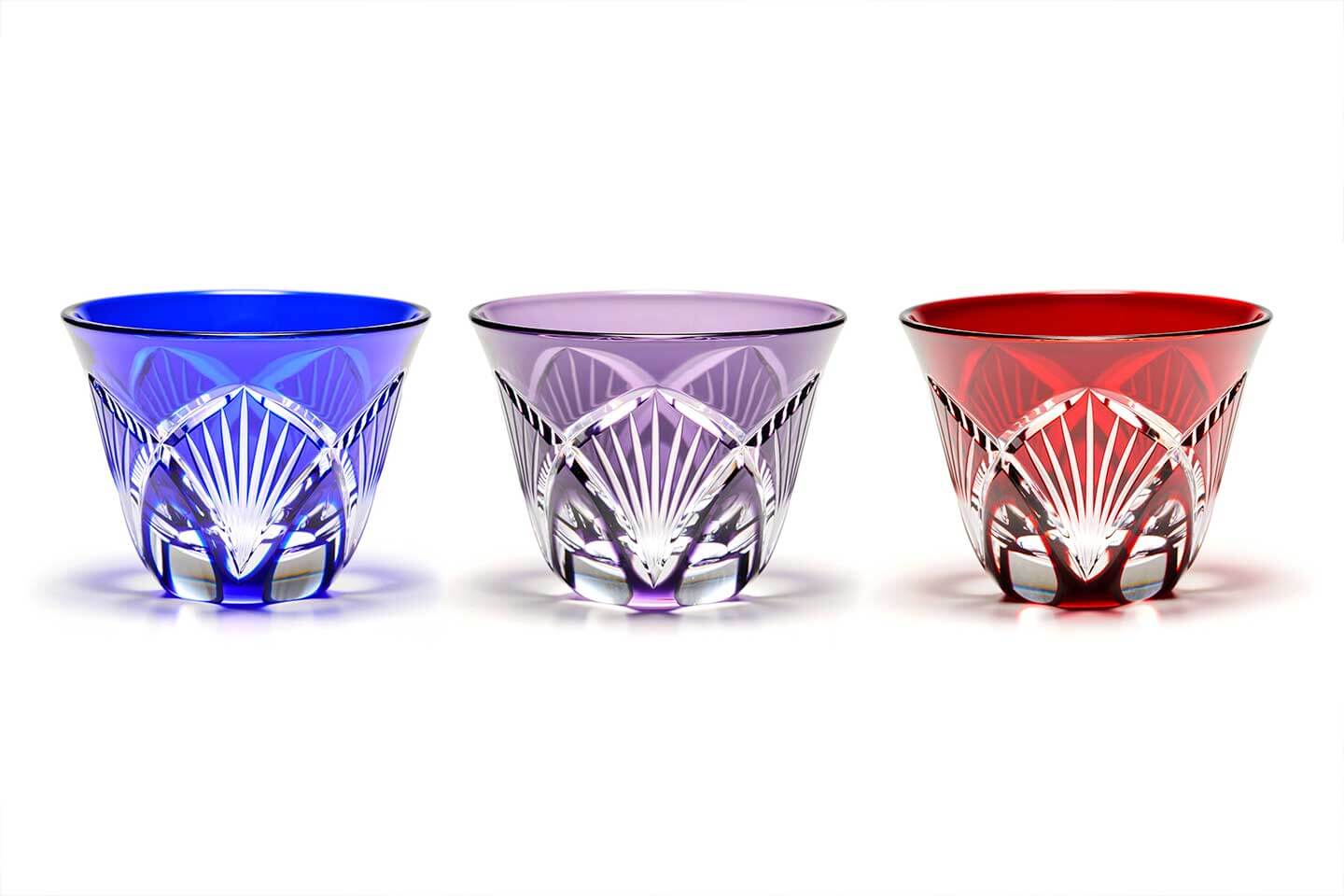
Looking for a Tokyo souvenir that combines centuries-old artistry with modern sophistication?
Edo kiriko glassware delivers exactly that—intricate geometric patterns hand-cut into crystal that shimmer like captured starlight.
These stunning pieces represent freedom from mass-produced mediocrity, each cut made by master artisans who’ve spent decades perfecting their craft.
Three reasons Edo kiriko speaks to independent spirits:
- Each piece defies conformity through unique, irreproducible cutting patterns
- You’re supporting small workshops over corporate manufacturers
- The designs break from tradition while honoring historical techniques
Visit Sumida district workshops where artisan branding and luxury packaging transform simple tumblers into collectible art.
Prices range from ¥5,000 for sake cups to ¥50,000 for elaborate vases, but you’re investing in genuine craftsmanship that’ll outlive fleeting trends.
Tenugui Cotton Towels: Functional Art You’ll Actually Use
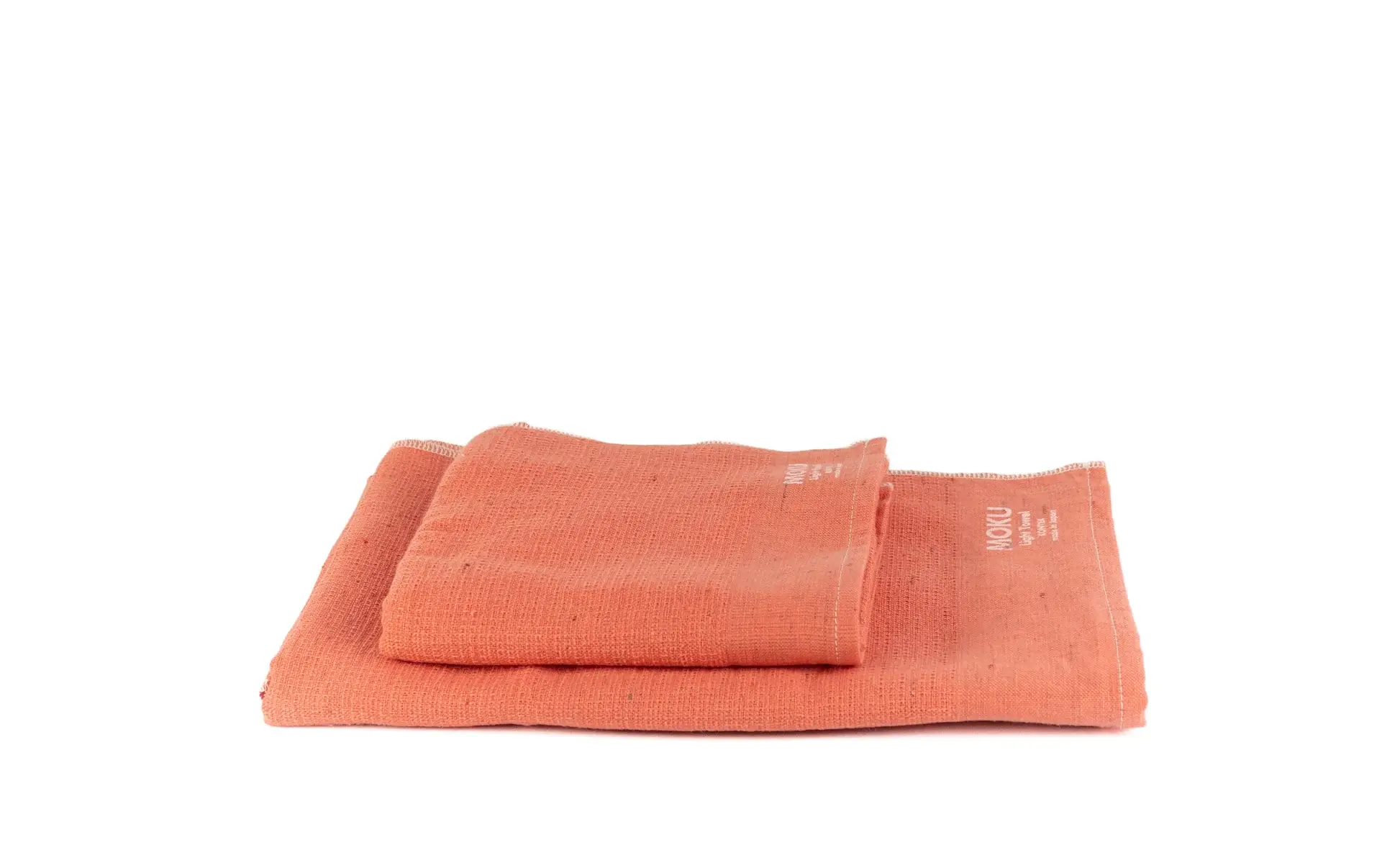
The humble tenugui might just be Japan’s most underrated souvenir—a thin cotton rectangle that works as headband, gift wrap, wall art, hand towel, and about seventeen other things your typical tourist trinket could never dream of becoming.
These 35×90cm cloths transform traditional motifs into everyday utility, featuring everything from cherry blossoms to geometric patterns that wouldn’t look out of place in a Brooklyn loft.
Hunt them down at Kamawanu in Daikanyama or Chusen Kobo in Asakusa, where artisans still hand-dye each piece using century-old techniques.
You’ll spot designs celebrating sumo souvenirs imagery and samurai memorabilia aesthetics, all printed on breathable cotton that actually improves with washing.
Pack a dozen home—they’re lightweight, multipurpose, and cost less than that overpriced temple keychain.
Kokeshi Dolls and Contemporary Wooden Crafts
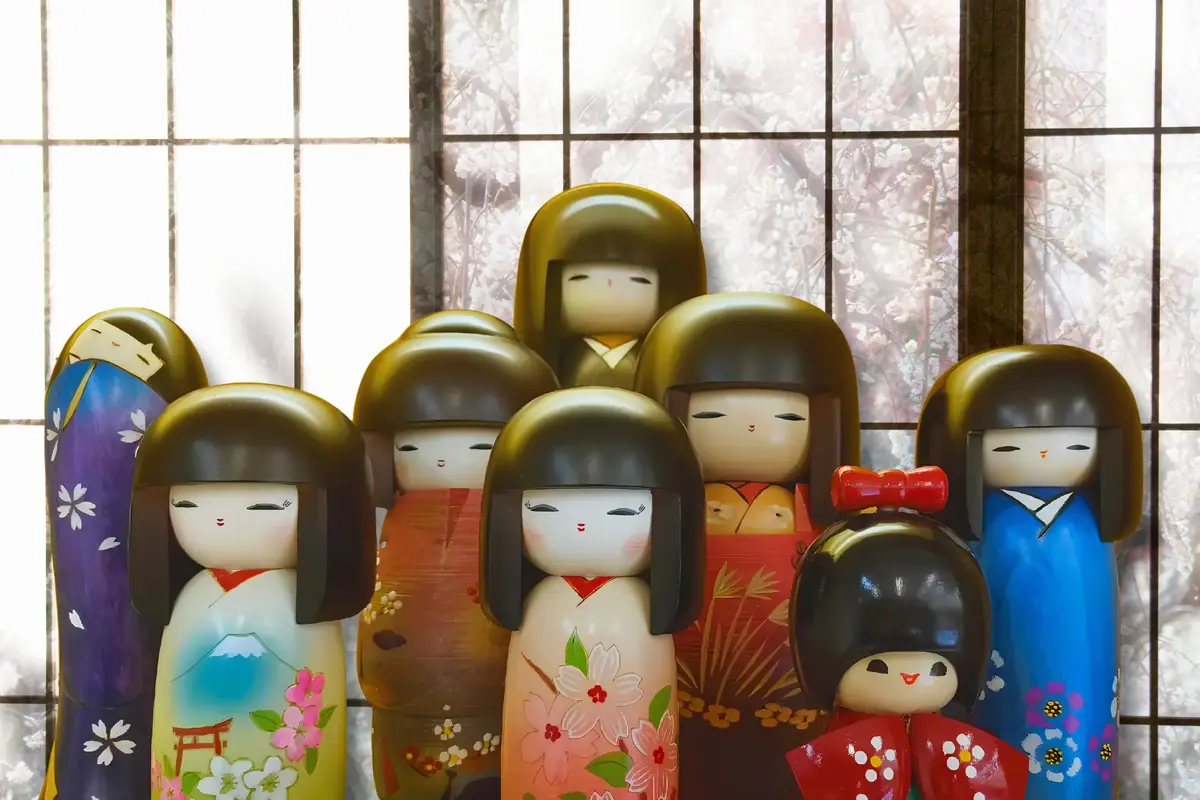
The narrow workshops tucked into Tokyo’s traditional neighborhoods are where third- and fourth-generation craftspeople still shape wood into kokeshi dolls using techniques passed down through centuries—and trust me, watching a master work is like witnessing pure meditation in motion!
Authentic pieces display specific regional characteristics, from Tohoku’s simple painted faces to contemporary artists’ bold geometric patterns.
While mass-produced imitations lack the subtle hand-carved irregularities and natural wood grain that give each genuine doll its unique personality.
Look for the artisan’s signature stamp on the bottom, feel the smoothness of hand-sanded wood versus machine-buffed uniformity, and check if the paint has that slightly uneven, human quality that screams “made with actual hands, not a factory line.”
Where Master Artisans Still Work Their Magic
Where can visitors witness centuries-old craftsmanship meeting contemporary design in Tokyo’s most enthralling workshops?
These artisan workshops preserve craft traditions while welcoming curious travelers:
- Intimate studios in Asakusa where masters transform raw wood into heirloom pieces before your eyes
- Yanaka’s tucked-away ateliers offering hands-on creation sessions
- Kagurazaka’s workshop galleries blending demonstration spaces with showrooms
You’ll discover authentic creative freedom watching skilled hands shape tradition into tomorrow!
Spotting Quality: What Separates the Real Deal From Imitations
After observing master craftspeople work their magic, smart shoppers need to arm themselves with knowledge that distinguishes authentic treasures from convincing knockoffs.
Authenticity markers include official stamps, certificates from artisan guilds, and precise grain patterns in woodwork.
Counterfeit risks multiply in tourist-heavy districts, where mass-produced imposters flood souvenir shops.
Examine weight, finish quality, and pricing—genuine craftsmanship commands fair compensation, not bargain-basement deals!
Edible Souvenirs That Go Beyond Generic Snacks
While Tokyo Banana might dominate airport gift shops, savvy travelers know the city’s real edible treasures lie hidden in specialty stores and neighborhood confectioneries that locals actually frequent.
The truth is, Tokyo’s food scene extends far beyond those ubiquitous sponge cakes—you’ll find artisanal teas that transform daily rituals, regional sweets that tell stories of specific neighborhoods, and small-batch spirits crafted by master distillers who’ve perfected their techniques over generations.
These are the souvenirs that spark real conversations back home, the ones your friends will remember long after the last bite or sip.
Tokyo Banana Alternatives: Regional Sweets Worth the Hype
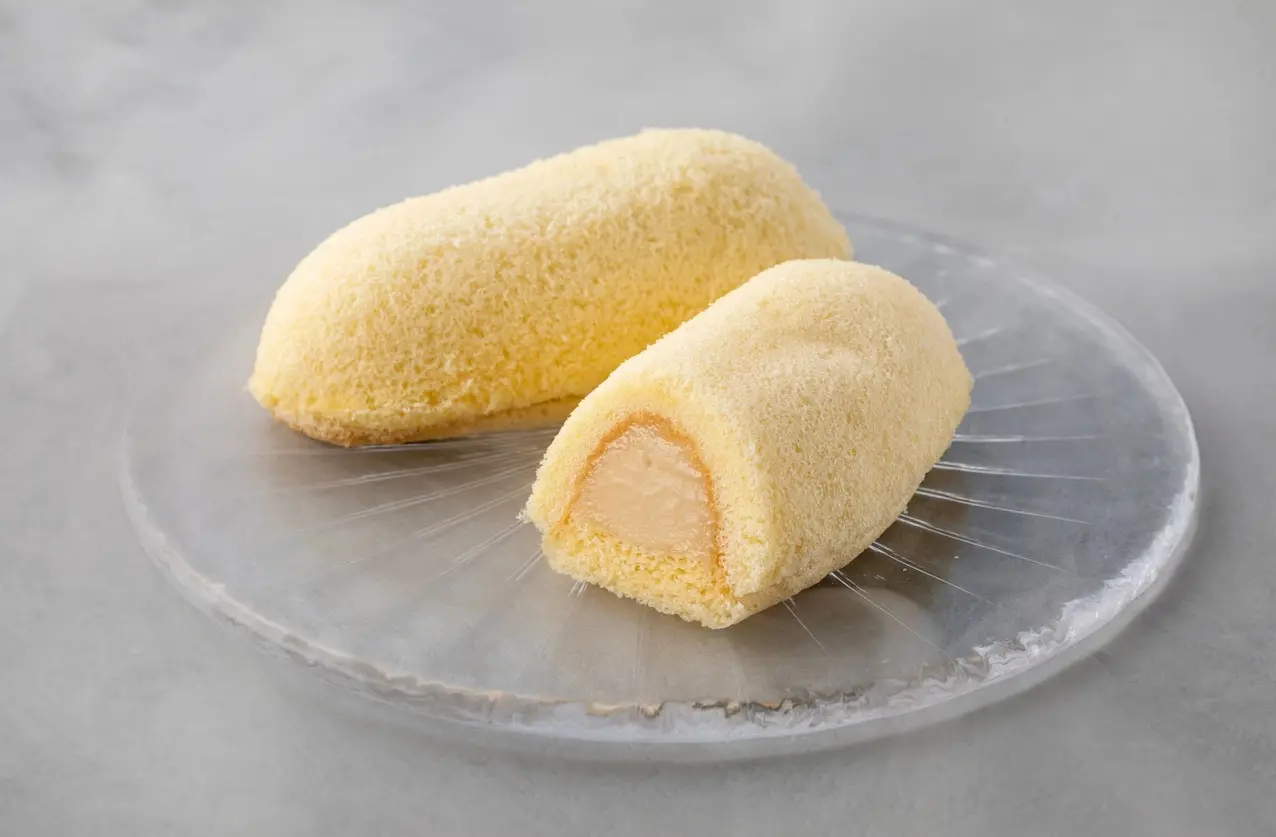
Tokyo Banana might dominate airport gift shops, but locals know the capital’s most memorable sweets come from heritage shops with decades—sometimes centuries—of perfecting their craft.
Head to Asakusa’s traditional storefronts for kaminari okoshi, those addictively crunchy rice puffs bound with millet jelly that have sustained pilgrims visiting Sensō-ji Temple since the Edo period.
For something unexpectedly elegant, Shiseido Parlour (yes, founded by the cosmetics giant) has been crafting French-inspired biscuits and caramels in Ginza since 1902, packaging them in tins so beautiful you’ll want to keep them long after the last buttery morsel disappears.
Kaminari Okoshi: Asakusa’s Crunchy Rice Candy Legacy
Since 1795, Kaminari Okoshi has been the crispy, caramelized rice candy that Asakusa shopkeepers have pressed into rounds and wrapped with the same meticulous care their ancestors used centuries ago.
This rice candy history tells a rebellious story—choose your own adventure through flavors:
- Classic millet: Earthy, honest sweetness
- Modern matcha: Green tea boldness
- Black sesame: Nutty independence
Break free from predictable souvenirs!
Shiseido Parlour: Century-Old Western-Style Treats

The cosmetics empire Shiseido opened its first soda fountain in Ginza back in 1902, transforming into a full-fledged parlour that still serves cheesecakes so legendarily smooth they’ve inspired three generations of copycat recipes across Japan.
Their butter cookies, packaged in elegant tins, marry the company’s cosmetic innovation philosophy with edible artistry.
It’s refined indulgence without the tourist-trap markup, perfect for friends who appreciate skincare rituals and sophisticated sweets equally!
Japanese Tea From Specialist Merchants

While generic souvenir shops peddle mass-produced tea bags with cartoon characters on the packaging, specialist tea merchants across the city offer something far more compelling—single-origin leaves hand-rolled by artisans, rare cultivars that sommeliers would recognize, and flavor profiles that’ll make recipients wonder why they ever settled for grocery store green tea.
Top specialty tea picks that break the mold:
- Gyokuro from Uji – this shade-grown premium green tea tastes like umami-rich liquid silk
- Hojicha roasted at small-batch intensity – smoky, caramel notes without caffeine jitters
- Sencha harvested during first flush – bright, grassy complexity that dances on your palate
These tea merchants don’t just sell leaves; they’re preserving centuries of cultivation wisdom while giving you freedom from mediocre beverage choices.
Craft Sake and Shochu: Bottles You Can’t Find Back Home

Before you start loading up your suitcase with premium sake and artisanal shochu, you’ll need to understand the actual rules—because the last thing you want is airport security confiscating that ¥15,000 bottle of aged junmai daiginjo you tracked down in a hidden Shibuya basement shop.
The good news is that travelers can typically bring alcohol in checked luggage (with limits on quantity and alcohol percentage that vary by country), though carry-on restrictions mean those bottles need to go in your main bag, not your backpack.
Check your home country’s customs regulations before you shop, since allowances range from a generous two liters duty-free in some places to much stricter limits elsewhere, and knowing these numbers beforehand means you can budget both your yen and your luggage space accordingly.
Navigating Customs: What You Can Actually Take on the Plane
Finding that perfect bottle of artisanal sake or small-batch shochu in Tokyo feels like discovering treasure—but international travelers need to understand the rules before packing these liquid gems in their luggage.
Your freedom-preserving flight checklist:
- Pack bottles in checked baggage only—airline restrictions and security checks prohibit liquids over 100ml in carry-ons.
- Wrap each bottle in bubble wrap and clothes for cushioning.
- Declare alcohol at customs (most countries allow 1-2 liters duty-free).
Fashion and Textile Finds in Tokyo’s Creative Districts
Tokyo’s creative districts overflow with textile treasures that make airport gift shops look downright embarrassing—these neighborhoods are where Japan’s legendary fabric artistry comes alive in ways visitors can actually take home.
From selvage denim crafted by artisans who treat each thread like a meditation practice to beautifully patterned furoshiki wrapping cloths that fold flat in suitcases, the fashion finds here blend centuries-old techniques with contemporary cool.
Also read: Tokyo Fashion Areas Comparison: Harajuku vs. Ginza vs. Shibuya Style Districts
Whether hunting for an indigo-dyed noren curtain in Kuramae or discovering hand-woven textiles in Nippori’s fabric district, shoppers will find pieces that tell stories far richer than any mass-produced souvenir ever could.
Denim From Japan’s Master Craftsmen
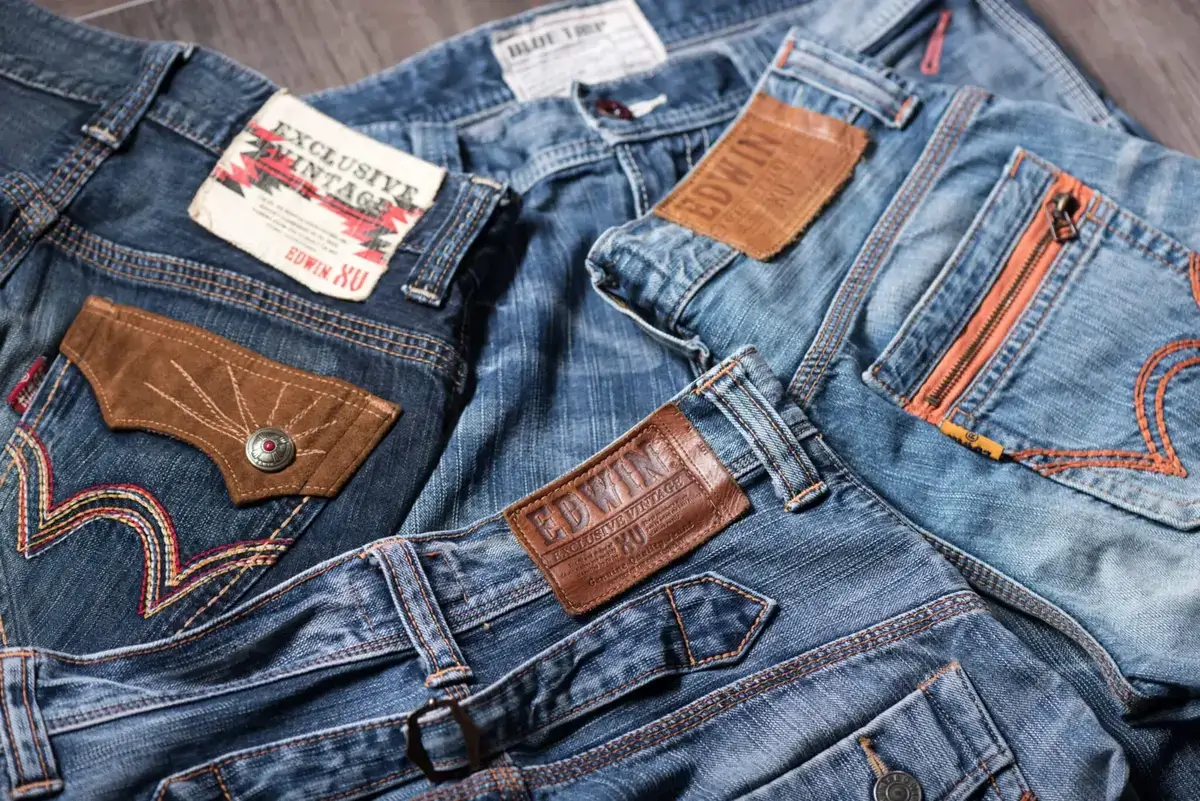
Japanese denim has earned its reputation as the world’s finest for good reason—the country’s artisans treat jean-making as an art form, using vintage shuttle looms, natural indigo dyes, and meticulous construction techniques that mass-market brands abandoned decades ago.
In Tokyo’s Harajuku and Shibuya districts, you’ll discover flagship stores where Japanese artisans showcase their denim craftsmanship through selvage edges, custom fades, and hand-stitched details.
Where to find exceptional denim:
- Momotaro Jeans in Harajuku—featuring the iconic peach motif and heavyweight fabric
- Pure Blue Japan for unconventional indigo shades and textured weaves
- Kapital in Ebisu for rebellious, artistic interpretations
These jeans break in beautifully, conforming to your body while developing character with every wear—true freedom expressed through fabric.
Furoshiki Wrapping Cloths: Sustainable and Stunning
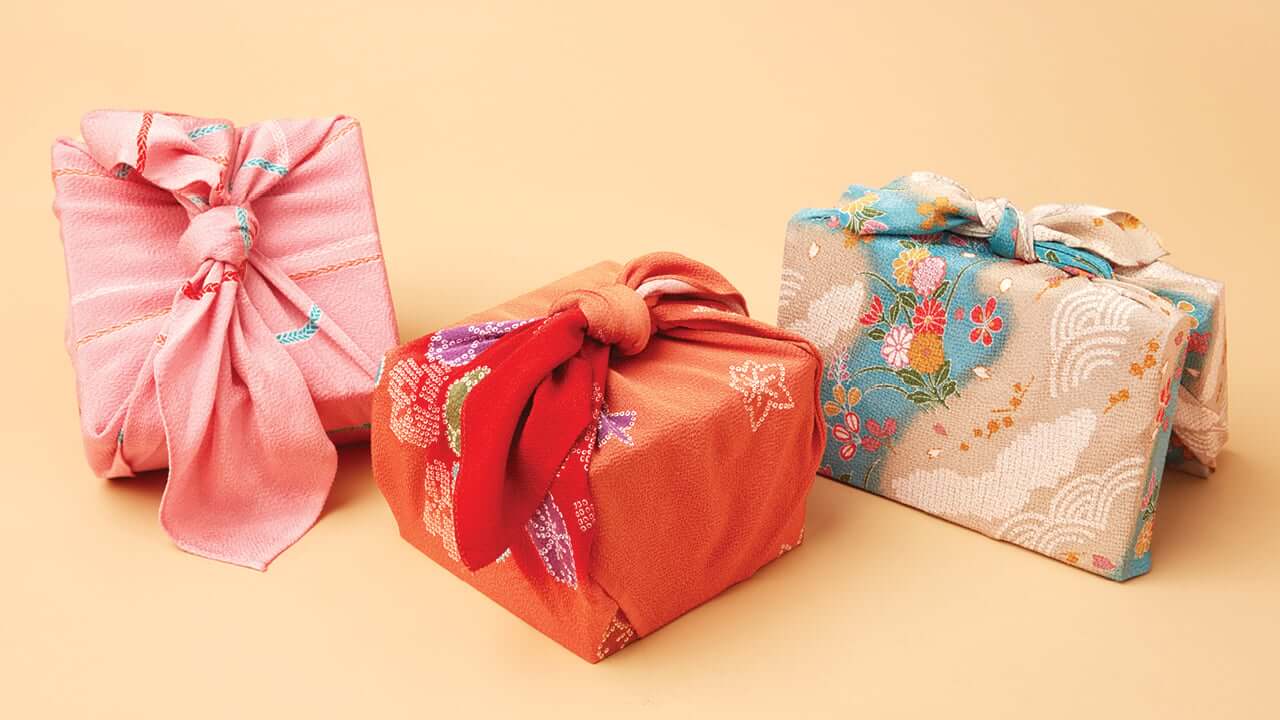
A simple square of fabric transforms into a gift wrapper, shopping bag, bottle carrier, or scarf—this is the ingenious versatility of furoshiki, Japan’s traditional wrapping cloth that’s been elegantly solving packaging problems for over 1,200 years.
Contemporary designs range from minimalist geometric patterns to lively kimono-inspired prints, making these reusable wrapping cloths both practical and collectible.
Tokyo’s best furoshiki selections await at Musubi in Asakusa and Kyukyodo in Ginza, where staff demonstrate folding techniques that’ll have you ditching disposable gift wrap forever.
These eco-friendly packaging alternatives fold flat in your luggage, weigh practically nothing, and actually get more beautiful with each use.
Starting around ¥1,500, they’re affordable souvenirs that keep on giving—your environmentally conscious friends back home will absolutely love them!
Noren Curtains That Transform Your Space
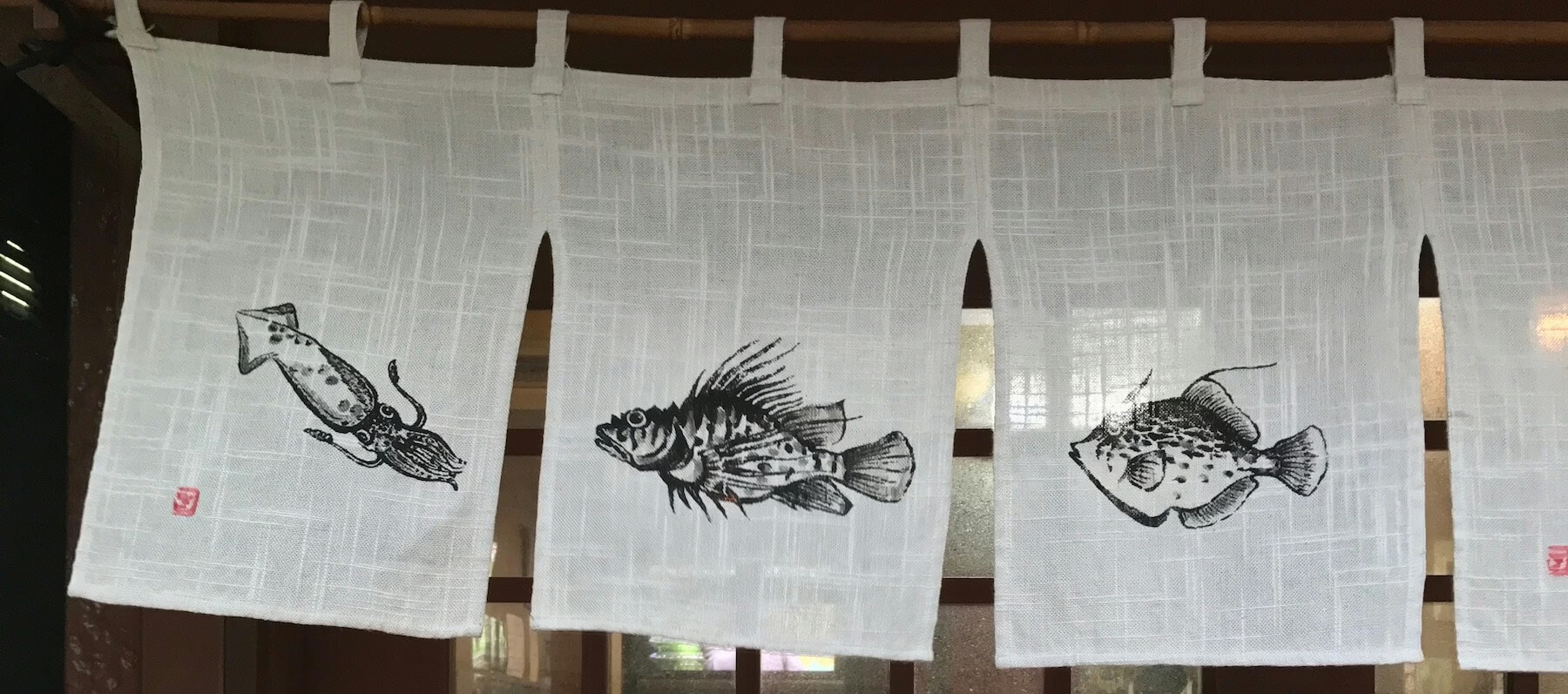
Getting these gorgeous fabric panels home is the easy part—it’s the hanging that requires a bit of creativity!
Standard noren measure around 85-90 cm wide and 150 cm long, perfect for doorways, but savvy shoppers can find narrower versions for windows or even use tension rods to section off rooms without drilling holes.
The beauty of noren lies in their adaptability: split them down the middle for traditional Japanese-style entryways, hang them as-is for bohemian room dividers, or even frame smaller pieces as textile art that’ll have guests asking where you scored such unique decor.
Sizing and Installation Tips for International Homes
When bringing noren curtains back from Tokyo, the most critical measurement to take into account is doorway width—standard noren typically measure 85-90 centimeters wide (about 33-35 inches), which fits most interior doorways in Japan but may look narrow in Western homes where doorways commonly span 30-36 inches.
Essential home sizing and installation tips:
- Purchase adjustable tension rods locally rather than hauling them internationally.
- Layer multiple noren side-by-side for dramatic, gallery-worthy statement walls.
- Mount them as room dividers to carve out personal sanctuary spaces.
Beauty and Wellness Products Made in Japan
Japan’s beauty and wellness industry has perfected the art of transforming ancient traditions into cutting-edge science, creating products that range from ultra-modern serums packed with sake extracts to handcrafted soaps made using centuries-old techniques.
Tokyo’s neighborhoods overflow with opportunities to discover these treasures—whether you’re hunting for that cult-favorite moisturizer in a sleek Ginza department store, seeking out artisanal soap makers in Asakusa’s traditional quarters, or exploring incense shops where fragrant sticks start at just a few hundred yen.
The city offers something for every budget and beauty philosophy, from minimalist skincare devotees to those who love elaborate multi-step routines.
Skincare Science: What Makes Japanese Products Different
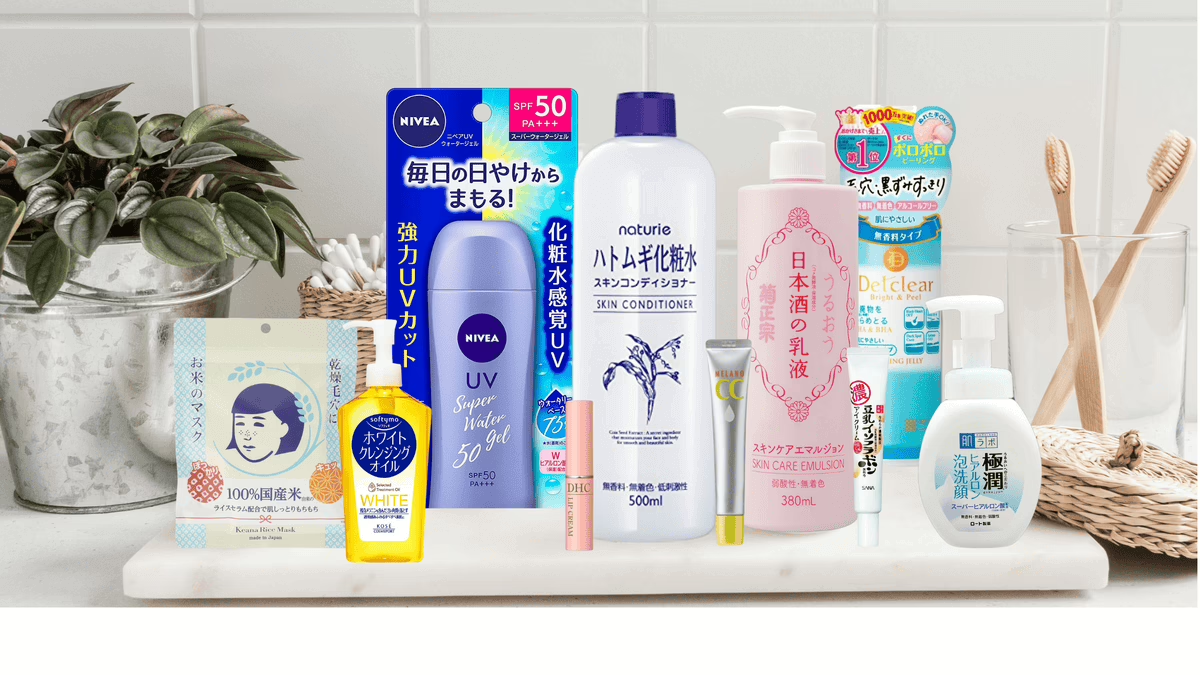
Japanese skincare products have earned their stellar reputation through a unique combination of cutting-edge biotechnology and centuries-old botanical knowledge that Western brands are only beginning to understand.
You’ll discover that skincare innovation here isn’t just marketing hype—it’s backed by serious research into fermentation processes, molecular-level ingredient purity, and skin barrier science that transforms how your skin actually functions!
What sets Japanese formulations apart:
- Fermented ingredients that your skin absorbs like never before, revealing nutrients impossible to access otherwise
- Rigorous testing standards that eliminate irritants before products ever reach shelves, giving you true peace of choice
- Lightweight textures that layer beautifully without that heavy, suffocating feeling Western moisturizers often create
The difference is genuinely transformative, not just another beauty trend you’ll abandon next month.
Traditional Handmade Soaps From Local Artisans
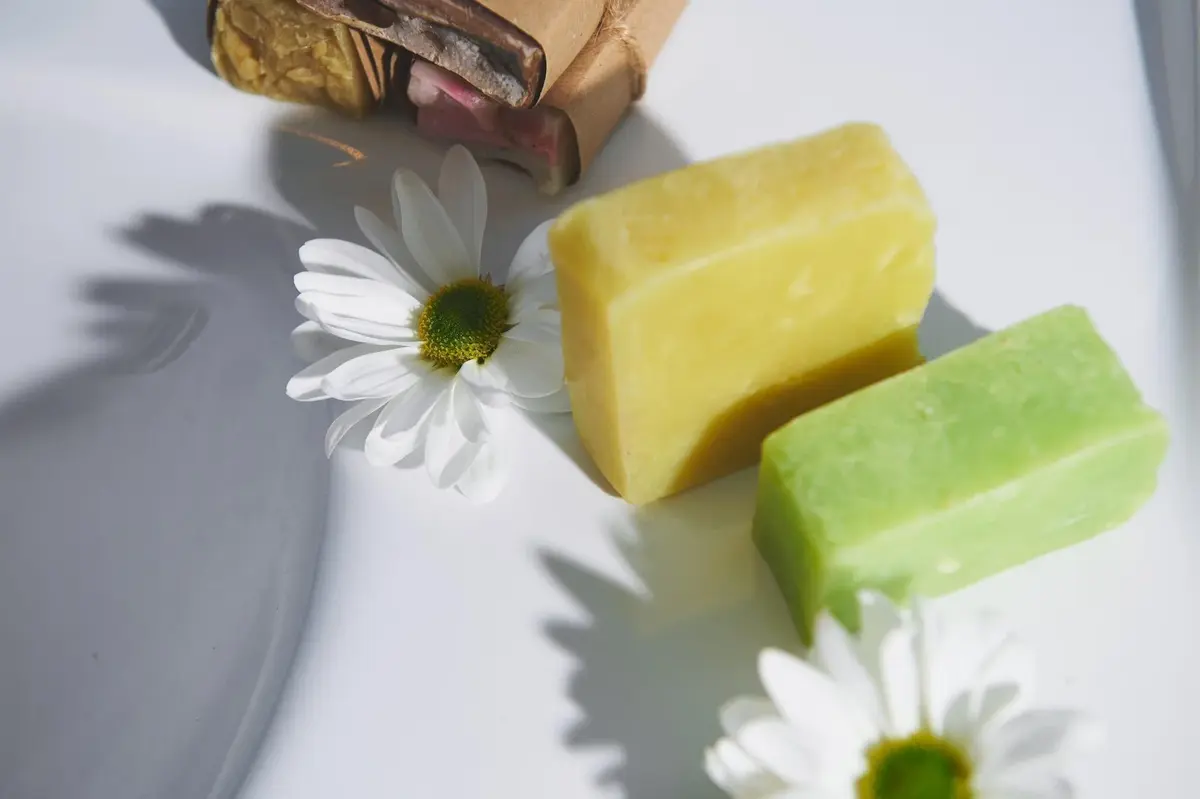
Where can travelers find soap that actually respects their skin while honoring generations of Japanese craftsmanship?
Tokyo’s local artisans create handmade soaps using traditional cold-process methods, blending indigenous ingredients like rice bran, camellia oil, and sake lees.
These aren’t mass-produced bars drowning in synthetic fragrances—they’re meticulously crafted pieces that transform mundane washing into ritualistic self-care.
Hunt for these treasures in Nakameguro’s boutique shops, where artisan collectives showcase their work, or explore Yanaka’s nostalgic streets lined with family-run workshops.
The handmade soaps typically cost ¥800-2,000, making them affordable luxuries that pack beautifully in luggage without adding weight.
Each bar tells a story of dedication to purity, sustainability, and skin health—qualities that resonate with anyone seeking authentic alternatives to corporate beauty standards.
Your skin deserves this level of respect!
Incense and Aromatics for Every Budget

Japanese incense shopping in Tokyo splits into two distinct worlds: the refined koh-do ceremony sets that can run several hundred dollars (think artisan-crafted tools, precious sandalwood chips, and instructional guides for the contemplative art of appreciating fragrance), and the everyday stick incense that costs just 500-1,500 yen per box.
Budget travelers shouldn’t skip the affordable options—brands like Nippon Kodo and Shoyeido produce stunning daily-use incense with scents ranging from traditional aloeswood to modern citrus blends, all crafted with the same attention to quality that defines Japanese manufacturing.
The ceremonial sets make extraordinary gifts for serious enthusiasts, but those lovely everyday sticks offer genuine Japanese craftsmanship without requiring you to skip meals for the rest of your trip!
Koh-do Ceremony Sets vs Everyday Sticks
How does one choose between the rarefied art of traditional koh-do incense ceremony and the simple pleasure of lighting a daily stick?
Your path depends entirely on your lifestyle and intentions:
- Koh-do ceremony sets open meditative rituals steeped in centuries of refinement.
- Daily sticks offer affordable aromatherapy freedom for spontaneous moments.
- Blend both approaches—ceremonial appreciation weekends, casual burning weekdays.
Stationery and Paper Goods for Creative Souls in Tokyo

Tokyo’s stationery scene isn’t just about pens and notebooks—it’s a full-blown obsession that transforms everyday writing into an art form.
From the delicate, translucent sheets of washi paper that craftspeople have been making for over a thousand years to the wildly creative masking tape designs you’ll only find in Tokyo’s specialty shops, these aren’t your average office supplies.
Whether you’re a seasoned calligrapher hunting for the perfect brush or a complete beginner ready to try your hand at shodo (Japanese calligraphy), the city’s stationery stores stock everything you need to channel your inner artist.
Washi Paper: Centuries of Tradition in Every Sheet

Beyond its inherent beauty, washi paper transforms into an array of practical treasures that travelers can actually use in their daily lives.
Sleek notebooks with silky-smooth washi covers become cherished companions for journaling or sketching.
Meanwhile, delicate greeting cards embossed with traditional patterns turn simple messages into keepsakes worth framing.
For hands-on creative types, curated origami sets—complete with premium washi sheets in stunning gradients and metallic finishes—offer the perfect way to share a bit of Japanese artistry with friends back home, no prior folding experience required!
Functional Items: Notebooks, Cards, and Origami Sets
Washi paper transforms ordinary stationery into extraordinary keepsakes, and Tokyo’s specialty shops overflow with notebooks, greeting cards, and origami sets that showcase this centuries-old craft.
These functional treasures deliver souvenir authenticity without luxury branding’s inflated prices:
- Hand-bound notebooks featuring traditional patterns
- Letterpress greeting cards with seasonal motifs
- Premium origami sets containing intricate, museum-quality sheets
Each piece celebrates your creative independence!
Tokyo-Exclusive Masking Tape Designs
While decorative tape might seem like an unlikely souvenir star, Japan’s masking tape scene—particularly in Tokyo—has evolved into something of a cult phenomenon that creative travelers absolutely need to experience.
Major brands like mt and Kamoi release Tokyo exclusive patterns featuring cherry blossoms against skyline silhouettes, vintage train maps, and miniature sushi motifs that you won’t find anywhere else.
Hunt for limited editions at Itoya in Ginza, where entire floors showcase masking tape designs in kaleidoscopic variety, or explore Tokyu Hands in Shibuya for collaborations with local artists.
These adhesive treasures transform ordinary journals into artful keepsakes, stick beautifully to any surface without residue, and pack flat—making them perfect freedom-friendly souvenirs that won’t weigh down your wandering spirit or strain your budget.
Calligraphy Supplies for Beginners and Experts
Getting started with Japanese calligraphy (shodo) requires just a few essential tools: a brush (fude), ink stick (sumi), grinding stone (suzuri), and quality paper—and Tokyo’s art supply districts make assembling your kit surprisingly straightforward!
For beginners, head to the art supply floors of major department stores like Tokyu Hands in Shibuya or Sekaido in Shinjuku, where helpful staff can guide you through starter sets that won’t break the bank.
Advanced practitioners should make a pilgrimage to the specialty shops in Kuramae or the traditional brush makers near Sensoji Temple in Asakusa, where master craftsmen create tools so perfectly balanced they practically write on their own.
What You Need to Start and Where to Get It
For anyone enthusiastic to immerse themselves in Japanese calligraphy, the essential toolkit is surprisingly minimal yet wonderfully specific.
Following proper souvenir etiquette, browse local markets where authentic supplies await discovery.
Your starter collection needs just three elements:
- Quality brushes with bamboo handles that feel alive in your hand
- Smooth ink stones for meditation-like grinding rituals
- Rice paper that transforms strokes into dancing art
Kitchen Tools That Japanese Chefs Actually Use
Tokyo’s kitchenware scene isn’t about trendy gadgets that clutter your drawers—it’s about tools so perfectly designed that professional chefs save up for them, then pass them down through generations.
The city’s specialized districts house everything from hand-forged knives that require appointments to purchase, to minimalist ceramic bowls turned by master potters who’ve spent decades perfecting their glazes.
Whether you’re hunting for a cast iron teapot in Kappabashi or selecting cypress bento boxes in Asakusa, these aren’t just souvenirs—they’re legitimate upgrades to your cooking life that’ll make you think of Tokyo every single day.
Ceramic Tableware From Tokyo’s Pottery Districts
The pottery districts scattered throughout Tokyo’s northeastern quarters—particularly Asakusa and Kappabashi—house centuries-old ceramic studios where master craftsmen still throw clay using techniques passed down through generations.
These are precisely the places where professional Japanese chefs source their everyday kitchen essentials.
You’ll discover regional pottery styles ranging from rustic Mashiko-ware to sleek contemporary designs, each showcasing distinctive ceramic glaze techniques that transform simple bowls into conversation pieces.
Must-buy pieces that’ll revolutionize your table:
- Hand-thrown rice bowls with that perfect thumb-grip indent
- Sake cups featuring crackled glazes that develop character over time
- Serving platters displaying dramatic iron-oxide patterns
These aren’t mass-produced tourist trinkets—they’re functional art pieces that honor Japan’s deep respect for everyday rituals.
Japanese Knives: Investment Pieces Worth Considering
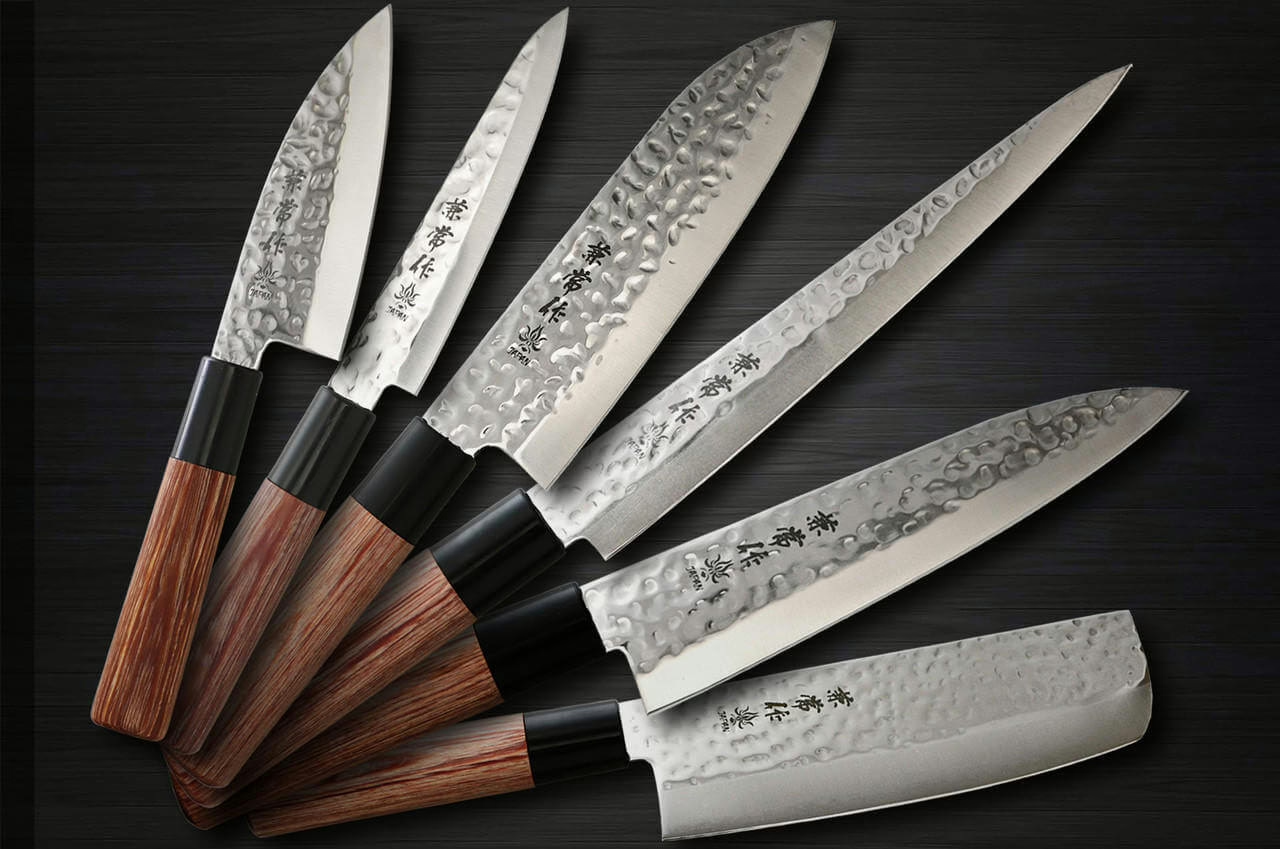
A premium Japanese knife represents a serious investment, but it’s only as good as the care you give it—which means you’ll need the right maintenance supplies to keep that razor-sharp edge performing like a dream.
Most knife shops in Kappabashi and upscale department stores sell whetstones (waterstones), honing oils, and specialized cleaning products, often demonstrating proper sharpening techniques right there at the counter.
For travelers worried about maintaining their blades back home, many Tokyo shops offer mail-in sharpening services, though locals swear by finding a trusted knife sharpener in their own neighborhood once they return.
Maintenance Supplies and Sharpening Services
Investing thousands of yen (or hundreds of dollars) in a premium Japanese knife means absolutely nothing if the blade isn’t properly maintained—and here’s the reality check: those razor-sharp edges don’t stay that way on their own.
Essential maintenance tips and sharpening techniques include:
- Whetstones (toishi) – Traditional water stones that transform dull blades into surgical instruments
- Honing oils and cleaning solutions – Protective elixirs that prevent rust and corrosion
- Professional sharpening services – Master craftsmen who breathe new life into neglected edges
Bento Boxes and Lunch Accessories Beyond Cuteness

While souvenir shops overflow with Hello Kitty-adorned lunch boxes that look too precious to actually pack food in, Tokyo’s kitchenware districts reveal a completely different world of bento culture—one where functionality reigns supreme and professional-grade tools meet everyday lunch prep.
At Kappabashi Street, you’ll discover sleek thermal containers that maintain temperature for hours, silicone dividers that create customizable compartments, and watertight sealing technology borrowed from industrial design.
The real gems are compact lunchbox utensils—collapsible chopsticks with magnetic cases, multi-tool sporks crafted from lightweight titanium, and nesting containers that maximize space while minimizing bulk.
These bento accessories represent Japanese engineering at its practical finest, transforming mundane lunch-packing into an exercise in efficient minimalism that actually enhances your daily routine rather than cluttering your cupboards.
Cast Iron Teapots Built to Last Generations
Why do Tokyo’s most respected kitchenware shops dedicate entire sections to cast iron teapots when lightweight ceramic and glass options line adjacent shelves?
Because these hefty kyusu represent teapot durability at its finest—heirloom pieces that actually improve with age rather than deteriorate.
Three reasons cast iron deserves your luggage space:
- Temperature retention that keeps your matcha warm through unhurried conversations
- Natural seasoning that develops unique flavor characteristics over decades of use
- Multi-generational warranty (seriously, you’ll pass this down to your grandkids)
Hunt for authentic Nambu tekki designs in Kappabashi’s specialized shops, where artisans still hand-pour each piece.
The weight feels substantial in your hands—this isn’t disposable kitchenware.
You’re investing in freedom from replacement cycles, choosing quality over perpetual purchasing.
Japanese Pop Culture Collectibles Done Right in Tokyo
Tokyo’s pop culture scene delivers collectibles that range from pristine official merchandise to thrilling vintage discoveries, each category offering its own brand of treasure hunting excitement.
The city’s character goods stores stock limited-edition collaborations you simply can’t snag through international websites, while specialized shops in Nakano Broadway and Akihabara house retro gaming cartridges and classic toys that spark serious nostalgia.
Whether you’re hunting for exclusive anime figures, rare manga variants, or that specific Famicom game from your childhood, Tokyo’s collectors’ ecosystem rewards dedicated shoppers with finds that make online browsing feel utterly inadequate.
Limited Edition Character Goods From Official Stores
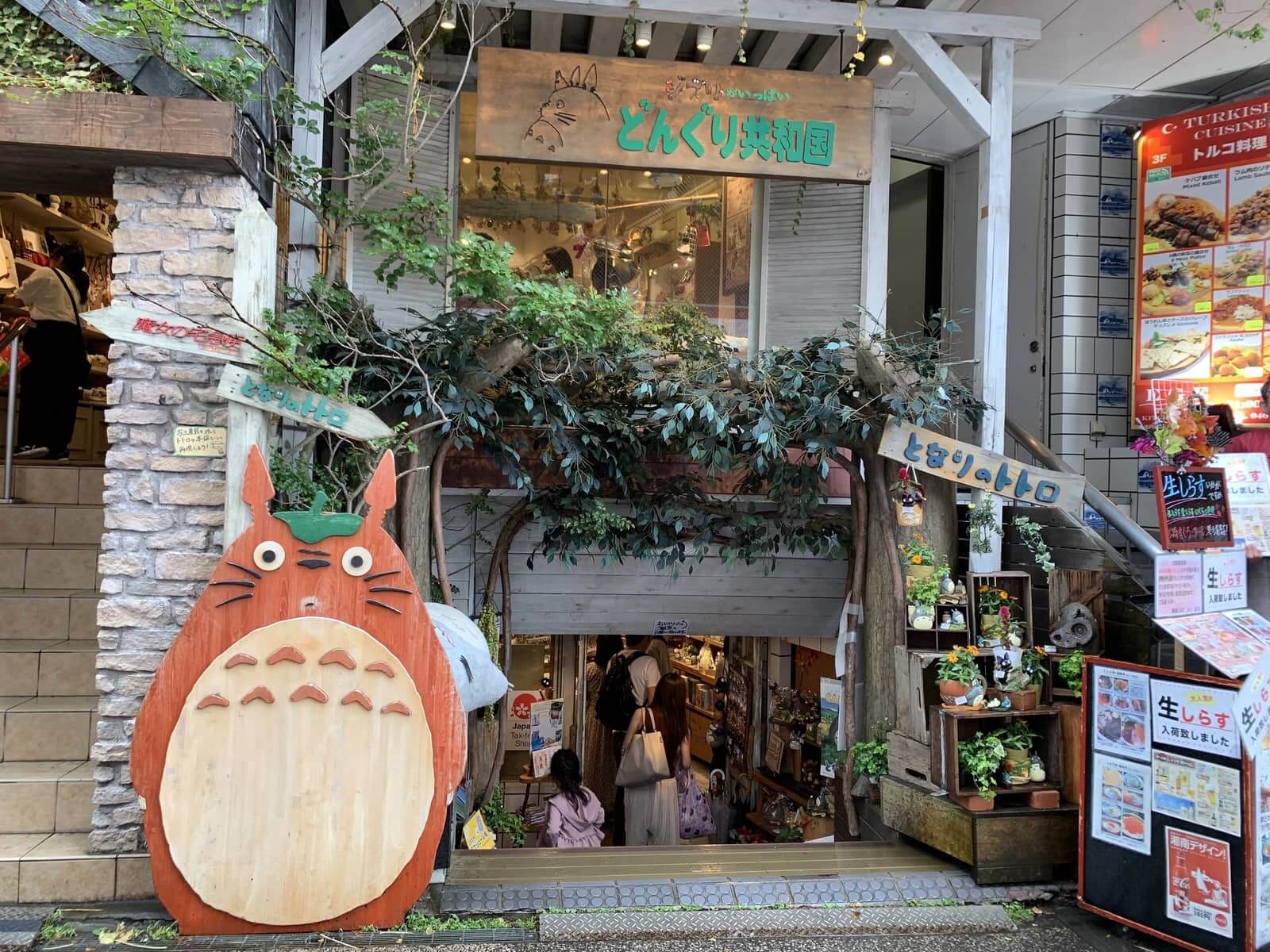
Japan’s official character stores transform shopping into treasure hunting, where exclusive merchandise drops create the kind of buzz that has collectors invigorating websites at midnight and lining up before dawn.
These aren’t your average tourist shops—they’re pilgrimage sites for anyone who values authenticity and exclusivity over mass-produced mediocrity.
Must-visit official stores for limited releases:
- Pokémon Center locations rotate seasonal collectible keychains you won’t find anywhere else.
- Sanrio Puroland shop debuts anniversary-edition themed stationery that sells out within hours.
- Studio Ghibli Store in Shibuya stocks region-exclusive items that make standard airport souvenirs look pathetic.
The thrill lies in scoring something genuinely rare, something that screams “I was actually there” rather than “I grabbed this at duty-free.”
Vintage Toys and Retro Gaming Finds in Tokyo
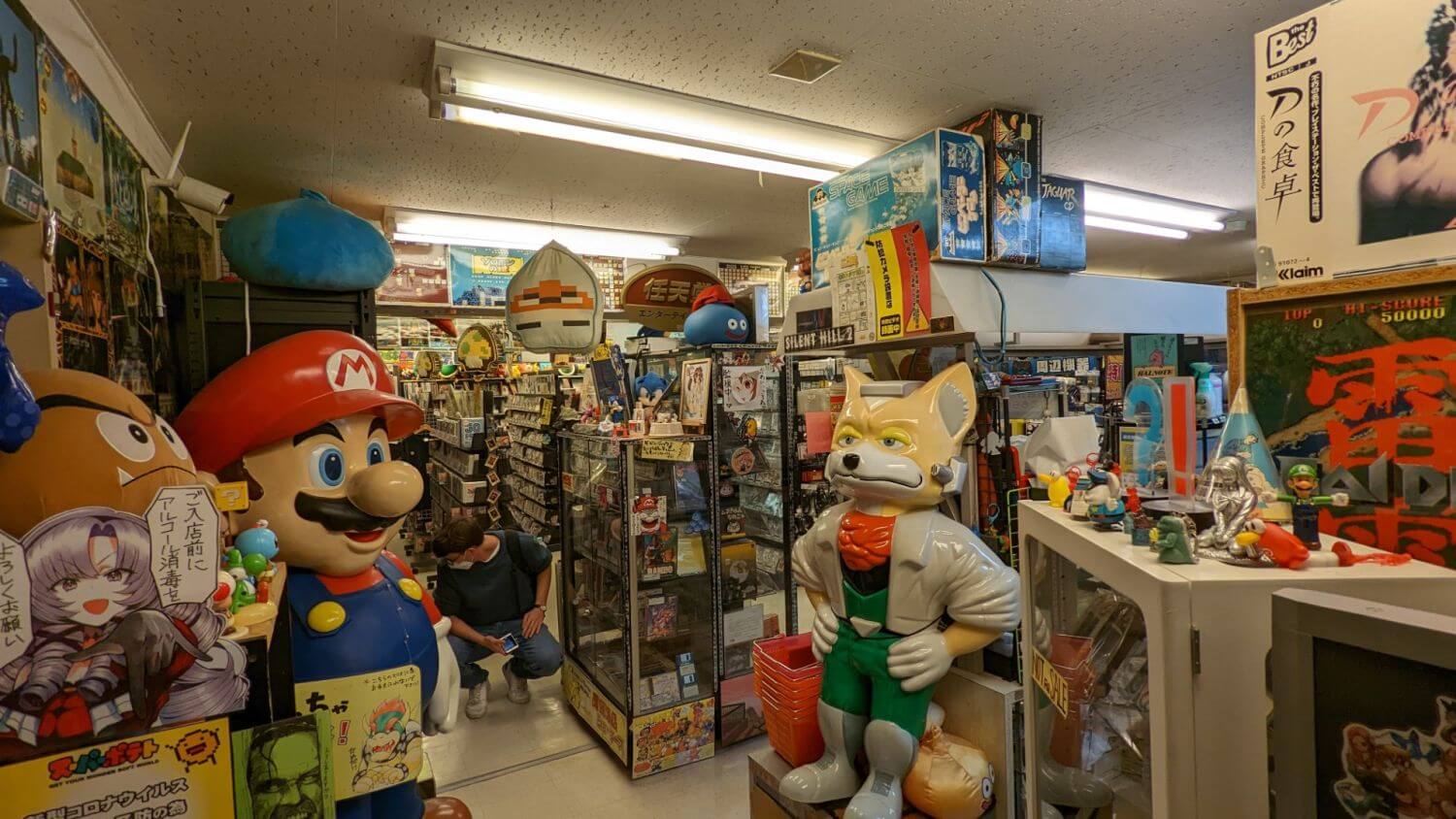
Beyond the flashy main streets of Akihabara lie cramped second-floor shops and basement stores where serious collectors hunt for treasures—think original Famicom cartridges still in their factory wrapping, vintage Tamagotchis in colors never released stateside, and pristine Super Sentai action figures from the 1980s.
These hidden gems don’t advertise much (if at all), so you’ll need to wander the side streets near Chuo-dori, peek into buildings with minimal signage, and climb questionable staircases that look like they lead to someone’s apartment.
The payoff, though, is access to meticulously curated collections where shop owners can recall the provenance of each item and might even pull something special from the back room if they sense you’re a true enthusiast.
Akihabara’s Hidden Gem Shops for Serious Collectors
While most tourists flock to the flashy mega-stores lining Chuo Dori, serious collectors know that Akihabara‘s真の宝物 (true treasures) hide in the cramped second-floor shops and narrow side streets where rent is cheaper and inventory runs deeper.
Top picks for independent hunters:
- Super Potato’s annex building—retro gaming paradise with mint-condition Famicom cartridges
- Mandarake Complex—eight floors of rare collectibles spanning decades
- Radio Kaikan’s upper floors—obscure doujinshi and limited-edition figures
Hunt freely without corporate interference!
Anime and Manga Merchandise in Tokyo You Won’t Find Online
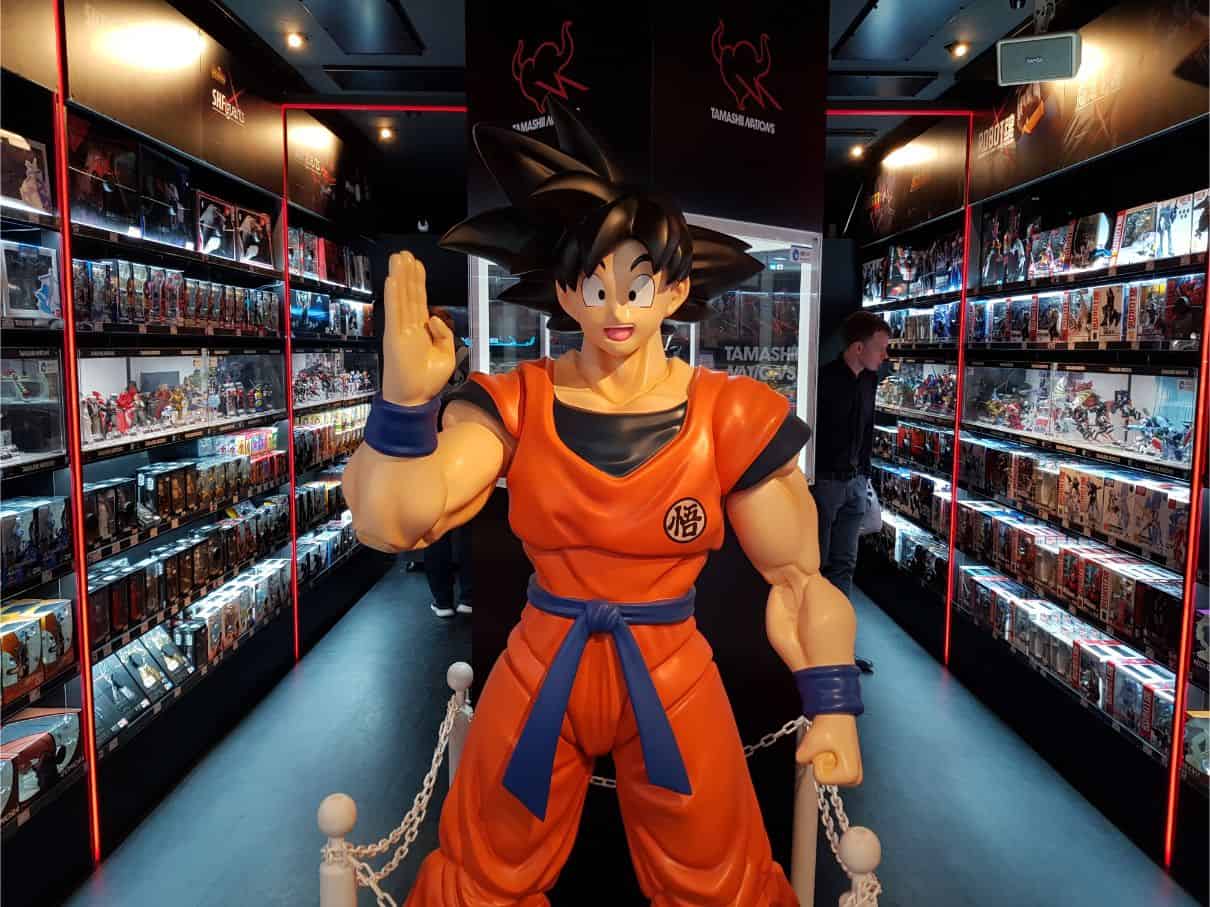
Tokyo’s specialty anime shops house treasure troves of limited-edition figures, doujinshi (fan-made comics), and collaboration merchandise that never make it to international retailers—these are the collector’s items that serious fans cross oceans to obtain.
Venture into Nakano Broadway’s labyrinthine corridors where Mandarake’s multiple floors overflow with vintage cel paintings and out-of-print manga art prints that’ll make your Instagram followers weep with envy.
K-Books in Ikebukuro specializes in character goods from niche series, plus cosplay accessories actually worn by Japanese enthusiasts at Comiket.
Don’t sleep on Animate’s exclusive bonus items—those illustrated cards and bromides come free with manga purchases but quickly become rarities.
These physical shops offer tactile browsing experiences that algorithm-driven websites simply can’t replicate, letting you stumble upon unexpected gems.
Home Decor That Captures Tokyo’s Aesthetic
Tokyo’s aesthetic genius lies in its ability to blend minimalist zen with playful charm, and bringing that vibe home means choosing pieces that genuinely transform a space.
The iconic maneki-neko (those adorable beckoning cats you see everywhere) aren’t just tourist trinkets—they’re legitimate cultural artifacts that range from traditional ceramic masterpieces to contemporary art interpretations.
Each paw raise and color choice carries specific meanings about wealth, health, or relationships.
Pair these lucky guardians with sleek Japanese ceramics or elegant shoji-inspired room dividers, and suddenly your living room channels that effortless Tokyo sophistication where ancient tradition meets ultra-modern design.
Maneki-Neko Lucky Cats: Choosing Your Perfect Guardian
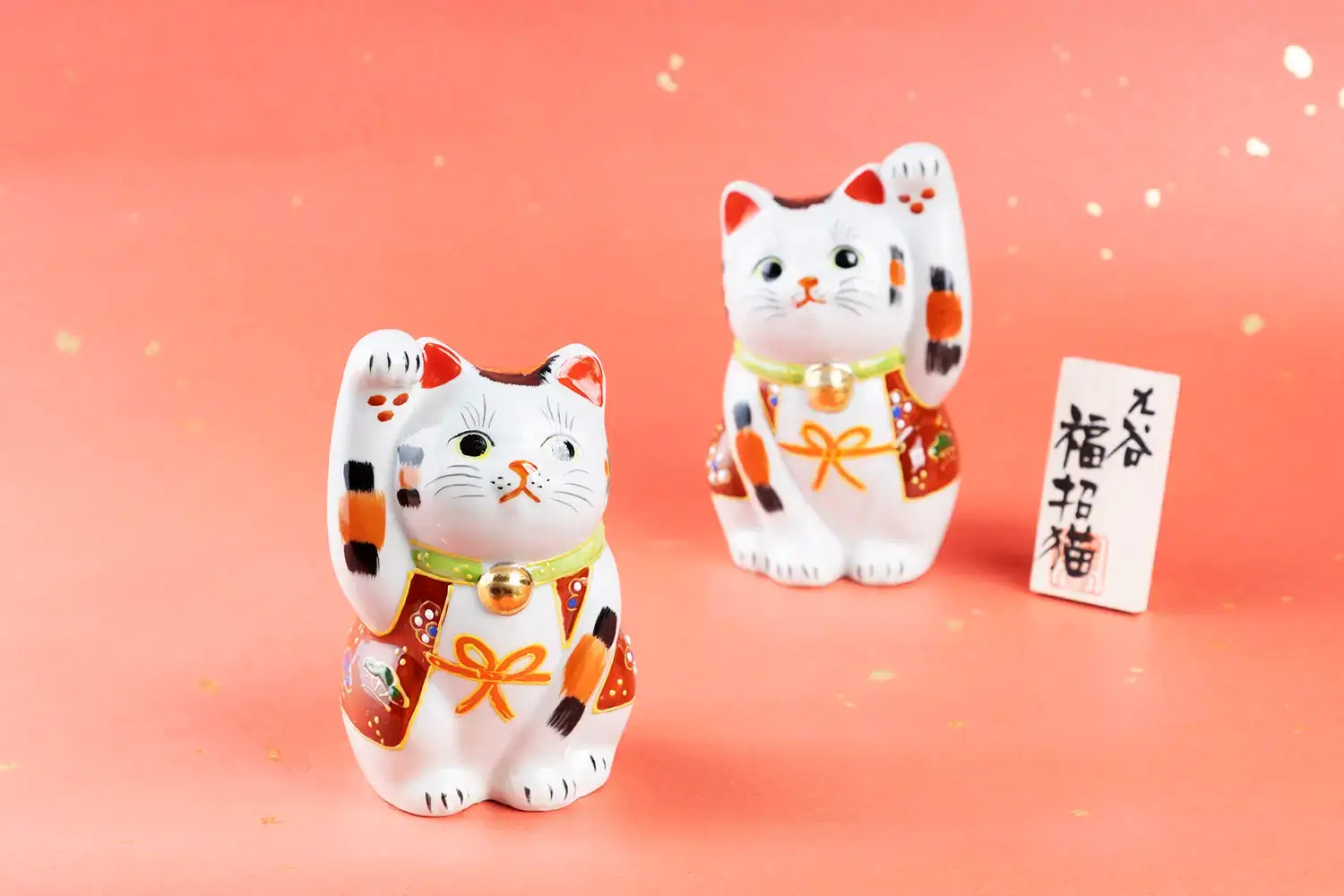
The iconic beckoning cat with its raised paw has welcomed customers and good fortune into Japanese shops for centuries, and bringing one home means capturing a piece of Tokyo’s living cultural heritage.
These guardian figures transcend mere decoration—they’re personal talismans you’ll choose based on your aspirations and aesthetic preferences.
Selecting your ideal lucky cat involves three key considerations:
- Paw position determines your fortune’s flavor—left paw attracts customers and connections, right paw draws wealth and prosperity
- Color carries symbolic meaning—classic white invites happiness, gold magnetizes money, black wards off evil spirits
- Size and craftsmanship reflect your commitment—from pocket-sized ceramic charms at Senso-ji Temple’s stalls to elaborate handcrafted masterpieces in Asakusa’s specialty shops
Your perfect maneki-neko awaits in Tokyo’s traditional districts!
Japanese Ceramics for Modern Living Spaces
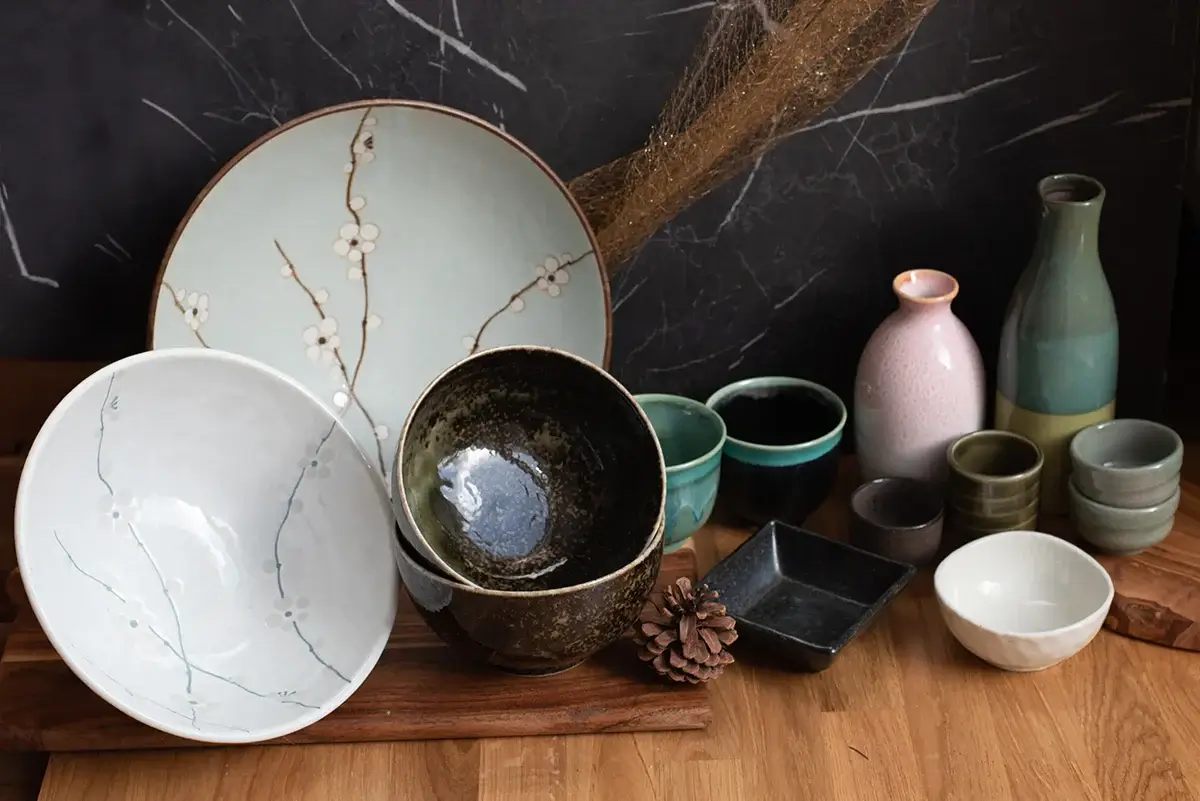
Beyond those charming beckoning cats lies an entire universe of Japanese ceramics that can transform a living room shelf or dining table into a curated gallery of Tokyo’s timeless aesthetic.
Kappabashi Street offers restaurant-grade tableware at prices that won’t demolish your budget, where sleek rice bowls and teacups embody minimalist aesthetics without sacrificing personality.
For modern decor enthusiasts, districts like Aoyama and Daikanyama showcase independent pottery studios where artisans blend centuries-old techniques with contemporary silhouettes—think matte-finished sake sets and asymmetrical plates that make every meal Instagram-worthy.
These pieces aren’t fragile museum artifacts; they’re durable, dishwasher-safe companions designed for daily use.
Each handcrafted item carries subtle imperfections called “wabi-sabi,” celebrating beauty in authenticity rather than sterile perfection.
Shoji Screen Elements and Room Dividers
Getting your gorgeous shoji screen or room divider back home might seem intimidating, but most specialty shops in neighborhoods like Asakusa and Nakameguro offer international shipping services that take the stress out of transporting larger pieces.
Many stores partner with experienced freight companies who know exactly how to pack these delicate wooden frames and washi paper panels so they arrive at your doorstep in perfect condition.
Though you’ll want to budget an extra ¥15,000-50,000 depending on size and destination.
Some shops even provide white-glove delivery services where professionals will assemble your screen in your home—now that’s what I call bringing Tokyo’s tranquil aesthetic straight to your living room!
Shipping Options for Larger Purchases
Shipping beautiful shoji screens and traditional room dividers back home might seem intimidating, but Tokyo’s shops have mastered the art of international delivery!
Most specialty stores handle all shipping logistics themselves, coordinating with trusted international courier services to make certain your treasures arrive safely.
Your hassle-free options:
- Store-arranged shipping with full insurance coverage
- White-glove delivery service for delicate pieces
- Custom crating that protects intricate latticework during transit
Best Shopping Districts for Authentic Souvenirs in Tokyo
Tokyo’s best souvenirs aren’t hiding in airport gift shops—they’re waiting in specialized neighborhoods where locals actually shop.
Each district offers its own distinct flavor of authentic finds.
From temple-side streets packed with traditional crafts to professional kitchen supply quarters and retro shopping lanes, these areas transform souvenir hunting from a chore into a genuine adventure.
The secret is knowing which neighborhood matches what you’re after, whether that’s centuries-old craftsmanship, serious cooking tools, nostalgic treasures, or handmade contemporary creations.
Nakamise-dori: Navigating Asakusa’s Historic Shopping Street
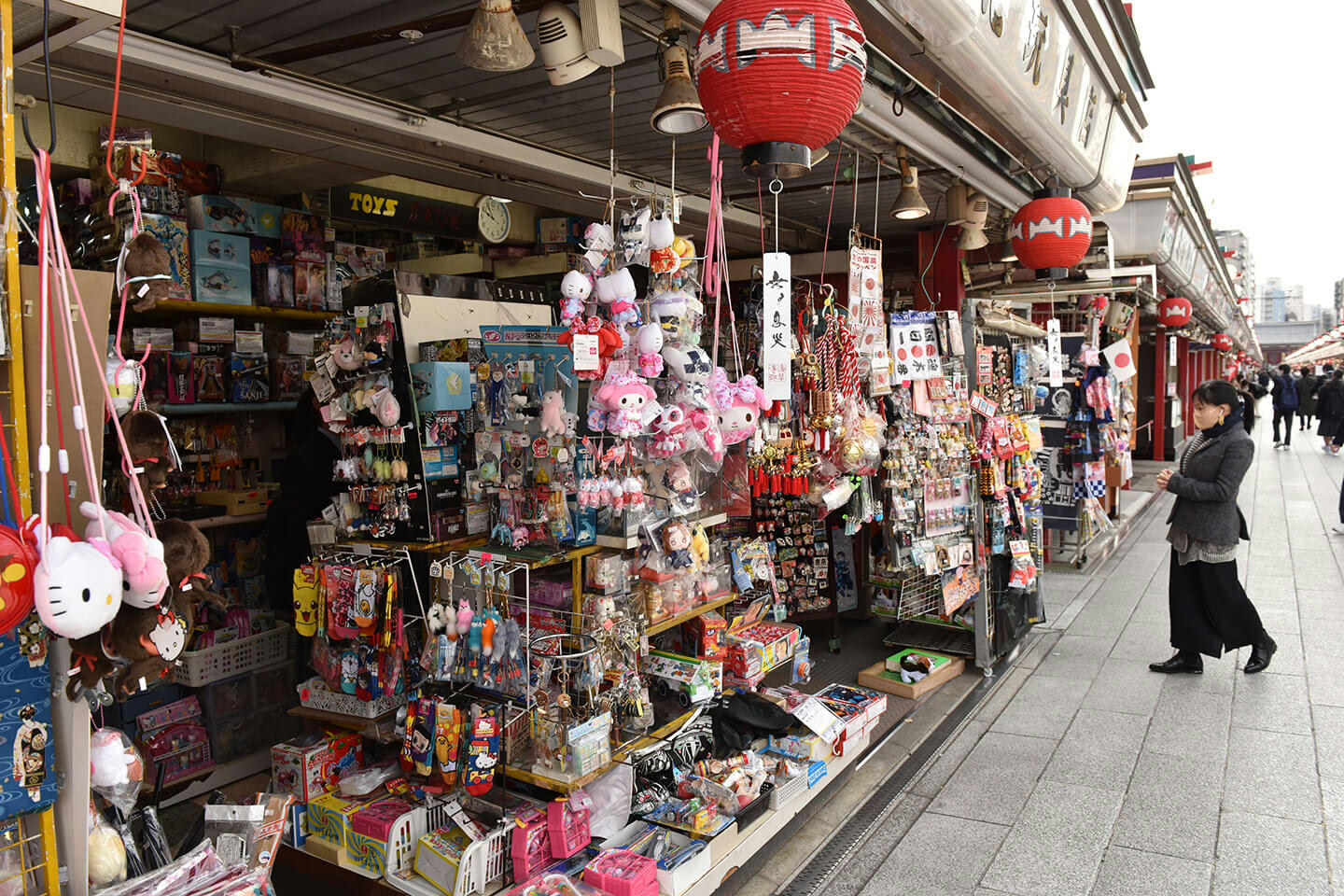
Stretching nearly 250 meters from the iconic Kaminarimon Gate to the steps of Sensō-ji Temple, Nakamise-dori stands as Japan’s oldest shopping arcade and remains one of Tokyo’s most electrifying destinations for traditional souvenirs.
Unlike sterile tourist shops, this lively thoroughfare pulses with authentic energy, where vendors have perfected their crafts across generations.
You’ll discover treasures that rival those found in local street markets and antique alleyways throughout the city.
Must-buy items that capture Tokyo’s spirit:
- Hand-painted folding fans that whisper ancient stories
- Freshly-made senbei crackers you can watch artisans grill
- Intricately designed tenugui towels showcasing stunning patterns
Arrive early morning to explore freely before crowds descend, giving you first pick of limited handmade items and genuine interactions with shop owners enthusiastic to share their heritage.
Kappabashi Kitchen Town: Where Tokyo Restaurants Shop
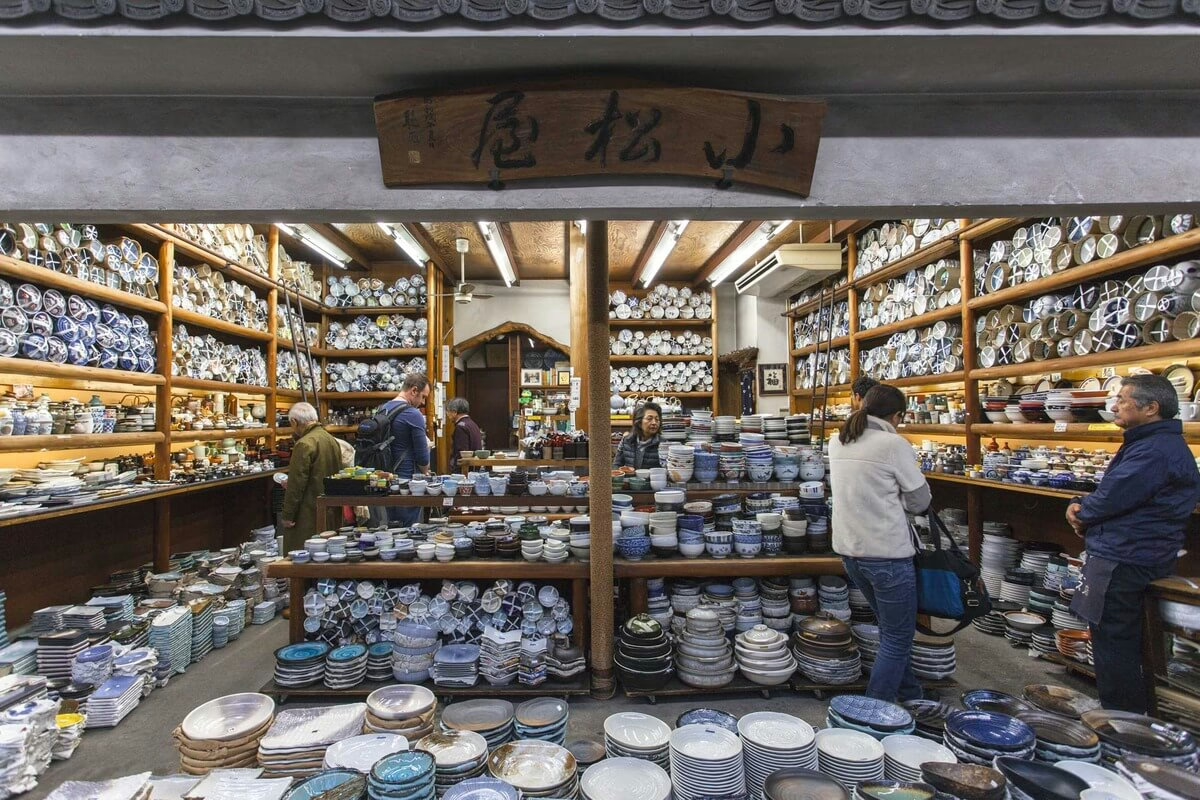
Walking through Kappabashi means encountering two distinct product tiers: the restaurant-grade tools that professional chefs rely on daily, and the beautiful but less durable tourist versions designed more for display than heavy-duty cooking.
The difference shows up immediately in the weight, balance, and price—a professional carbon steel knife might cost ¥15,000-30,000 and require regular maintenance, while its tourist counterpart sits pretty at ¥3,000 with stainless steel that needs zero special care.
Smart shoppers should honestly assess their cooking habits before investing, because that gorgeous copper tamagoyaki pan will develop its famous patina only if someone actually uses it!
Professional vs Tourist-Grade Items Explained
The difference between professional-grade and tourist souvenirs in Kappabashi becomes immediately apparent when comparing a ¥500 novelty knife to a ¥15,000 Masamoto chef’s blade—one makes for a cute Instagram post, while the other gets passed down through generations of sushi chefs.
What professionals actually buy:
- Carbon steel knives requiring daily maintenance and lifetime commitment
- Handcrafted ceramic pieces over mass-produced collectible figurines
- Restaurant-quality tools instead of branded merchandise marketed to visitors
Yanaka Ginza: Old Tokyo Charm With Artisan Shops
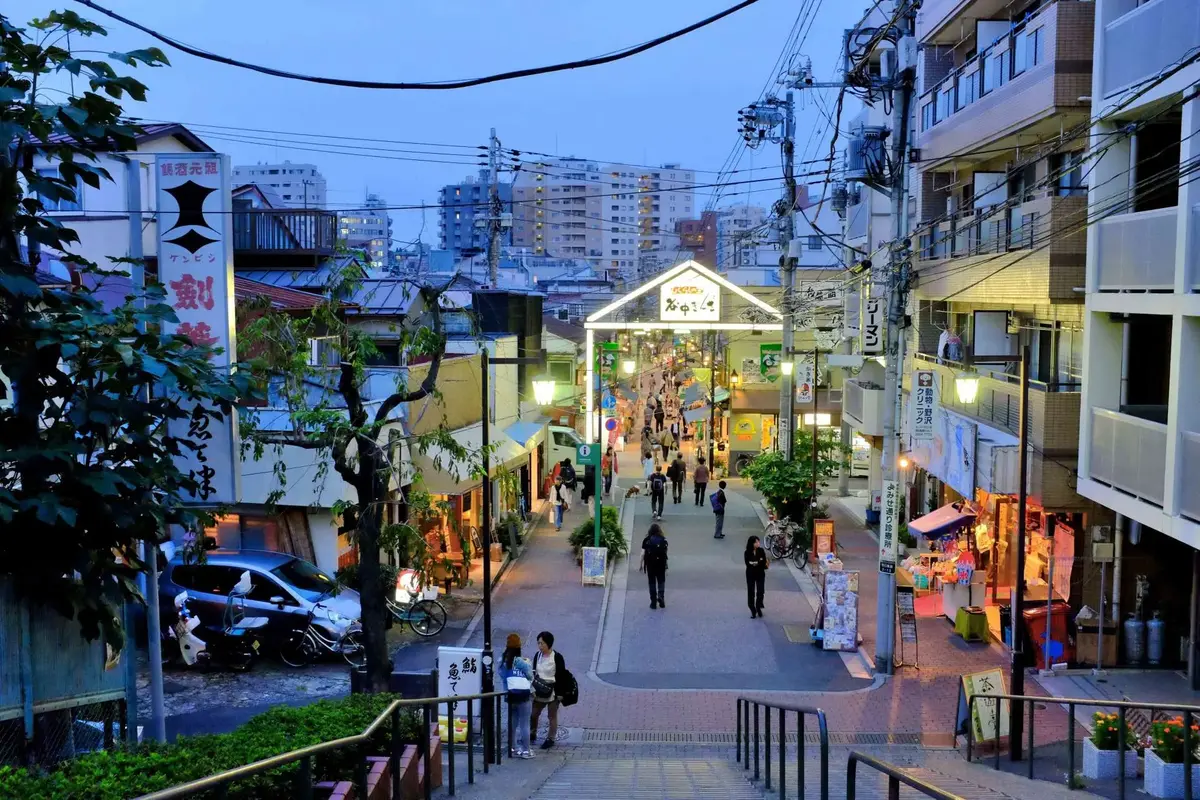
Why settle for mass-produced trinkets when Yanaka Ginza offers a glimpse into Tokyo’s artisan soul, tucked away in one of the few neighborhoods that survived the city’s wartime devastation?
This charming shotengai (shopping street) delivers authentic boutique shopping without the tourist markup or crowds.
You’ll discover local artisan workshops where craftspeople shape everything from handmade wooden combs to traditional fabric pouches right before your eyes.
The neighborhood’s crown jewel?
Sunset views from Yuyake Dandan (Sunset Stairs), where cats lounge between pottery studios and family-run confectioneries.
Wander freely through narrow lanes where each shop tells its own story—no corporate chains, no pressure tactics.
Visit weekday mornings for the most intimate experience, when shopkeepers have time to share their craft’s history and recommend hidden gems around the corner.
Shimokitazawa’s Vintage and Handmade Scene
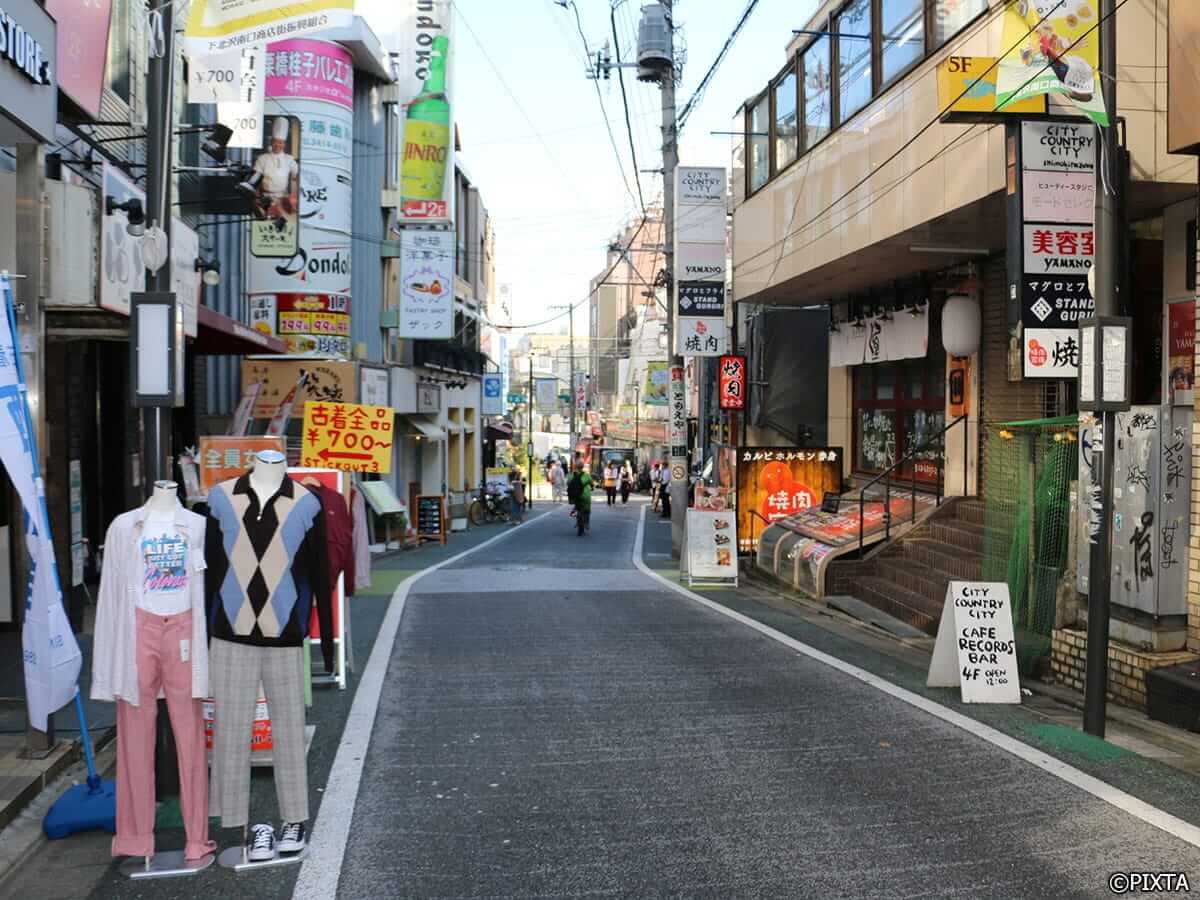
How does a neighborhood manage to feel simultaneously like a bohemian time capsule and Tokyo’s beating creative heart?
Shimokitazawa delivers exactly that paradox, drawing independent spirits to its maze of narrow lanes crammed with vintage fashion boutiques and handmade jewelry ateliers.
This is where Tokyo’s creative rebels escape corporate conformity!
Three Essential Shimokitazawa Experiences:
- Thrift treasure hunting through multilevel vintage stores bursting with perfectly curated ’70s denim and retro kimonos
- Discovering artisan jewelry makers crafting unique pieces in tiny workshops you’ll stumble upon accidentally
- Café-hopping between purchases to fuel your shopping marathon with exceptional coffee
The neighborhood radiates authentic counterculture energy without pretension.
Forget sanitized shopping malls—Shimokitazawa’s chaotic charm rewards explorers willing to wander aimlessly, discovering one-of-a-kind souvenirs that actually mean something.
Specialty Stores That Locals Recommend in Tokyo
While tourists often gravitate toward souvenir shops packed with key chains and Hello Kitty merchandise, savvy travelers know that Tokyo’s best treasures hide in the specialty stores where locals actually shop.
These aren’t your average retail spots—they’re institutions where Japanese craftsmanship, innovation, and everyday life converge in the most spectacular ways.
From underground food halls that’ll make you rethink what “grocery shopping” means to multi-story temples of clever design, these stores offer souvenirs that your friends back home have definitely never seen before.
Department Store Basement Food Halls: Depachika Done Right
Smart shoppers know that timing can transform a depachika visit from overwhelming chaos to treasure-hunting paradise, especially when those coveted half-price stickers start appearing on premium items.
Most department store basements get slammed during lunch (11:30 AM-1:30 PM) and evening rush (5:00-7:00 PM), but roll in around 3:00 PM for breathing room, or better yet, arrive 30-60 minutes before closing when vendors mark down fresh items that won’t survive until tomorrow.
The real locals’ secret?
Weekend mornings right at opening (usually 10:00 AM) offer the freshest selection without the stampede, while late Sunday evenings bring the deepest discounts as stores prepare to close for their weekly rest day.
Timing Your Visit to Avoid Crowds and Score Deals
Although depachika can feel overwhelming during peak hours, savvy shoppers know that timing transforms these basement wonderlands from chaotic mazes into treasure troves of culinary discoveries.
Strategic shopping windows open the best experiences:
- Weekday mornings (10-11 AM) offer pristine displays and unhurried browsing.
- Evening close-out sales (7-8 PM) deliver festival shopping excitement with seasonal discounts on bento boxes.
- Post-holiday periods reveal clearance treasures without tourist crowds blocking your path.
Tokyu Hands: Seven Floors of Japanese Innovation
Tokyu Hands stands as a seven-story temple to Japanese creativity and problem-solving ingenuity, where everyday items transform into unexpectedly brilliant design solutions.
This retail wonderland showcases the same innovative spirit that brought you modern vending machines dispensing hot ramen and capsule hotels reimagining urban accommodation.
Navigate floors packed with meticulously organized gadgets, stationery that makes writing feel luxurious, and home goods you never knew you desperately needed.
The basement beauty section rivals department stores, while upper floors explode with crafting supplies, travel gear, and kitchen tools that solve problems you haven’t encountered yet.
Shibuya’s flagship location offers tax-free shopping and English-speaking staff who genuinely enjoy demonstrating products.
Expect to spend hours browsing—smart shoppers arrive with specific gift lists but leave happily sidetracked by discoveries.
Muji Flagship Stores: Minimalist Design at Its Finest
Muji’s flagship stores embody the Japanese philosophy of “no-brand quality goods” through spaces so thoughtfully designed they feel like walking meditation for your shopping soul.
The Yurakucho and Ginza locations showcase minimalist design at its zenith, where functional aesthetics transform everyday objects into quiet statements of rebellion against consumer excess.
Here’s what makes these temples of simplicity irresistible:
- Stationery paradise featuring gel pens that glide like butter and notebooks begging for your unfiltered thoughts
- Travel essentials compressed into ingenious packages that maximize your precious luggage space
- Aroma diffusers capturing Japan’s seasons in bottles you’ll actually want displayed
You’ll discover freedom in their philosophy: own less, live better, choose quality that whispers rather than shouts.
Seasonal Souvenirs Worth Timing Your Trip For
Tokyo’s souvenir scene transforms completely with each season, offering limited-edition treasures that serious collectors and casual shoppers alike plan entire trips around.
The city’s retailers and artisans release special seasonal items that capture the essence of Japan’s distinct quarters—from sakura-printed everything in spring to lucky charms that appear only during New Year’s preparations.
Timing a visit to coincide with these seasonal releases means snagging exclusive items that simply won’t exist three months later, making them truly irreplaceable mementos of a perfectly timed Tokyo adventure.
Cherry Blossom Limited Editions in Spring
When should travelers start hunting for those impossibly pretty sakura-themed treats that flood Tokyo’s shops each spring?
Late February marks the beginning of this ephemeral shopping season, when department stores unveil their spring blossoms collections with ceremonial fanfare.
These seasonal souvenirs vanish faster than the petals themselves, typically disappearing by early May.
Top Cherry Blossom Limited Editions:
- Sakura Kit Kats – Strawberry-flavored pink wafers that capture spring’s fleeting beauty in every crispy bite
- Hanami-themed cosmetics – Shiseido and Jill Stuart release cherry blossom packaging that’s almost too gorgeous to open
- Artisan sakura tea sets – Delicate blends infused with pickled cherry blossoms, delivering spring’s essence year-round
Smart hunters visit Shibuya’s flagship stores mid-March, when inventory peaks but crowds remain manageable.
Summer Festival Goods and Yukata Accessories
As temperatures climb and humidity blankets the city, Tokyo transforms into a festival wonderland where summer matsuri souvenirs become the season’s most coveted treasures.
Hunt for intricately patterned summer yukata at Nakamise Shopping Street near Sensoji Temple, where traditional cotton robes hang in eye-popping arrays of indigo blues, sunset oranges, and cherry blossom pinks.
Festival accessories like jangling glass wind chimes, delicate uchiwa fans, and hair ornaments adorned with silk flowers create the perfect complement to your yukata ensemble.
Don Quijote stores stock affordable complete sets if you’re building your festival outfit from scratch, while boutique shops in Asakusa offer handcrafted pieces that double as wearable art.
These aren’t just souvenirs—they’re your passport to joining locals at riverside firework displays and neighborhood bon odori dances.
Autumn Leaves Motifs and Seasonal Sweets
Fall sweeps into Japan’s capital like a painter wielding a palette of crimson, gold, and burnt sienna, and nowhere does autumn express itself more deliciously than in the city’s seasonal confections and leaf-themed treasures.
The seasonal foliage inspires limited-edition treats you’ll find nowhere else!
Three autumn souvenirs worth the chase:
- Momiji manju – maple leaf-shaped cakes filled with chestnut or sweet potato paste that autumn gourmets devour by the dozen
- Lacquerware trays adorned with hand-painted ginkgo leaves, capturing Tokyo’s golden transformations in functional art
- Seasonal wagashi sets from venerable Ginza confectioners, where each delicate sweet mirrors the changing landscape outside
These treasures vanish faster than falling leaves, so time your visit for September through November when artisans release their most creative seasonal expressions!
New Year’s Decorations and Lucky Charms
How better to capture Japan’s spirit of renewal than through the dazzling array of New Year’s treasures that flood Tokyo’s markets from late December through early January?
New Year’s decorations like kadomatsu (bamboo-pine arrangements) and shimekazari (sacred rope ornaments) transform humble doorways into portals of good fortune.
Hit Sensoji Temple’s bustling stalls or Omotesando’s upscale boutiques to score these stunning pieces that locals genuinely display in their homes.
Lucky charms called omamori deserve serious attention—these silk-wrapped talismans promise everything from traffic safety to academic success.
Grab them at major shrines like Meiji Jingu, where massive crowds gather for hatsumode (first shrine visit).
Unlike mass-produced tourist trinkets, these authentic blessings carry actual cultural weight and make incredibly meaningful gifts for anyone seeking protection or prosperity.
Budget-Friendly Options That Don’t Look Cheap
Tokyo’s budget shopping scene rivals its luxury offerings in both quality and creativity, with countless wallet-friendly gems hiding in the most unexpected corners of the city.
The secret lies in knowing where locals actually shop—those humble 100 yen stores bursting with ingenious design, convenience stores stocked with regional exclusives you can’t find anywhere else, and neighborhood drugstores offering cult-favorite beauty products at prices that make international shoppers weep with joy.
These aren’t consolation prizes for a tight budget; they’re legitimate treasures that savvy Tokyo residents grab for themselves daily, packaged so beautifully that recipients back home will never guess the affordable price tag.
100 Yen Shop Treasures Hidden in Plain Sight
Not all 100-yen shops are created equal, and knowing which chains consistently deliver premium-looking goods can transform your souvenir game completely.
Daiso reigns supreme for its massive selection and surprisingly sophisticated home goods—think sleek minimalist chopsticks and elegant ceramic dishes that could pass for department store finds.
Meanwhile, Seria specializes in design-forward stationery and craft supplies with a distinctly aesthetic edge.
Can Do excels at practical travel accessories and compact beauty products that punch way above their price point.
Which Chains Stock the Best Quality Items
The savvy Tokyo shopper knows that Japan’s ubiquitous 100-yen shops have evolved far beyond their humble discount roots.
Now, they stock surprisingly sophisticated items that rival their department store cousins at a fraction of the price.
Top chain stores with quality assurance standards:
- Daiso – Premium stationery and minimalist home goods
- Seria – Curated design-forward lifestyle products
- Can Do – Travel-sized essentials and unique Japanese snacks
Konbini Exclusives: Convenience Store Surprises
Japan’s convenience stores stock an astonishing array of limited-edition treats and regional exclusives that put Western gas station snacks to shame—and at prices that won’t make anyone wince.
These conbini exclusives rotate constantly, with seasonal Kit Kat flavors, collaboration snacks with popular anime, and prefecture-specific sweets that locals actually seek out.
You’ll find matcha-everything, sake-infused chocolates, and beautifully packaged rice crackers for ¥200-500 that look gift-worthy despite their humble origins.
The real convenience surprises hide in the refrigerated sections: premium craft beers, artisan onigiri with wild salmon or mentaiko, and frozen desserts from celebrated Tokyo patisseries.
Check Lawson’s Uchi Café line or Family Mart’s collaborations with renowned chefs for genuinely impressive souvenirs that’ll spark conversations back home.
Drugstore Beauty Products at Unbeatable Prices
Tokyo’s drugstores—Matsumoto Kiyoshi, Welcia, Sundrug, and Tsuruha—function as beauty wonderlands where cult-favorite Japanese skincare and cosmetics cost a fraction of their international prices, yet arrive in packaging so sleek they’d feel at home in a Ginza department store.
You’ll discover affordable skincare that actually works, no gimmicks required.
Three drugstore beauty treasures worth hoarding:
- Hada Labo hyaluronic acid lotions that plump skin without the luxury markup
- Canmake cream blushes delivering department store quality for under ¥600
- Melano CC vitamin C serum that brightens stubborn dark spots relentlessly
The best part?
These products aren’t tourism cash-grabs—they’re what Tokyo locals genuinely stock in their bathroom cabinets.
Hunt the tax-free floors, compare prices between chains, and fill your suitcase with lightweight bottles that’ll revolutionize your routine without demolishing your budget.
Luxury Souvenirs for Special Occasions
For those milestone moments that demand something truly unforgettable, Tokyo’s luxury souvenir scene delivers treasures worthy of a lifetime’s safekeeping.
The city’s high-end offerings range from lustrous Mikimoto pearls that have defined Japanese elegance since 1893 to exclusive designer collaborations you won’t find anywhere else on the planet, making them genuinely special tokens of your Tokyo journey.
Whether you’re celebrating an engagement, a major anniversary, or simply want to commemorate your trip with something extraordinary, these premium picks transform ordinary gift-giving into an art form.
Mikimoto Pearls: Tokyo’s Jewelry Legacy
When one thinks of quintessentially Japanese luxury, few names command as much reverence as Mikimoto, the pioneering brand that transformed cultured pearls from scientific curiosity into coveted treasures worn by royalty and Hollywood stars alike.
This jewelry history began in 1893 when Kokichi Mikimoto revolutionized pearl cultivation, freeing these lustrous gems from ocean’s unpredictable depths.
Today, their Ginza flagship store beckons discerning shoppers seeking investment pieces that transcend fleeting trends.
Three reasons Mikimoto pearls make unforgettable souvenirs:
- Heirloom quality – These pearls appreciate in value and emotional significance across generations
- Unmatched luster – Mikimoto’s rigorous selection process ensures only 5% of cultivated pearls earn their name
- Personal expression – Customize designs that reflect your unique journey through Japan
Choose pieces that speak to your individual style, not societal expectations!
Designer Collaborations Available Only in Japan
Japan’s fashion powerhouses regularly reveal exclusive collaborations that never reach shelves in Paris, New York, or Milan—a delightful reality that transforms Tokyo’s department stores into treasure troves for collectors who understand that true luxury lies not just in brand names, but in scarcity itself.
The basement floors of Isetan Shinjuku and Ginza Six showcase luxury collaborations between Japanese artisans and international houses—think Hermès scarves with ukiyo-e prints or Louis Vuitton bags incorporating traditional Kyoto textiles.
These exclusive designer collections vanish within weeks, sometimes days, making them genuinely special mementos.
Dover Street Market Ginza pushes boundaries further with avant-garde pieces you’ll never spot stateside.
Visit weekday mornings for the best selection, and don’t hesitate—these limited editions reward decisive shoppers who value originality over mass-market accessibility!
Antique Finds From Oedo Antique Market
Before you hand over your yen for that gorgeous Meiji-era sake set or intricately carved netsuke, you’ll want to know what you’re actually buying!
Look for vendor stamps, artist signatures, or period-specific construction techniques—reputable sellers at Oedo will happily explain an item’s provenance and point out authentication marks that distinguish genuine antiques from clever reproductions.
While you don’t need to become an expert appraiser overnight, learning a few key indicators like patina patterns, joinery methods, and material quality will help you confidently invest in pieces that are worth every cent.
Authentication and Value Assessment Basics
The thrill of discovering a genuine Meiji-era ceramic piece at Oedo Antique Market can quickly turn sour if that treasure turns out to be a clever reproduction—which is why savvy shoppers arm themselves with basic authentication knowledge before pulling out their wallets.
Essential authentication steps for cultural significance and authenticity verification:
- Examine maker’s marks under natural light—real stamps show irregular depth and aging.
- Test weight and texture against known examples.
- Consult vendor expertise while trusting your research.
Smart Shopping Strategies for Tokyo Visitors
Shopping smart in Tokyo isn’t just about finding the perfect souvenir—it’s about stretching those yen as far as they’ll go!
Savvy visitors who master a few key strategies, from understanding Japan’s generous tax-free system to knowing which shops welcome haggling (spoiler: most don’t), can save serious cash while filling their suitcases with treasures.
Plus, steering through the city’s convenient shipping services means travelers can send bulky purchases straight home instead of wrestling them through airport security.
Tax-Free Shopping Explained: Maximizing Your Savings
When visitors discover they can reclaim Japan’s 10% consumption tax on eligible purchases, their souvenir budget suddenly stretches considerably further—and savvy shoppers know exactly how to access these savings.
The tax refund process transforms ordinary shopping into strategic treasure hunting.
Look for stores displaying “Tax-Free Shopping” signs, where qualifying purchases over ¥5,000 unlock instant duty free discounts at checkout—just present your passport and boom, you’re saving real money!
Three liberating truths about tax-free shopping:
- Electronics, cosmetics, and clothing qualify—your favorite Japanese beauty products suddenly cost 10% less
- Airport purchases work too—grab last-minute gifts without the guilt
- Multiple small purchases can combine—different items from the same store add up to meet minimums
Smart travelers leverage these savings to upgrade their souvenir game completely.
When to Bargain and When Prices Are Fixed
Why do some Tokyo visitors embarrass themselves attempting to negotiate at department stores while others miss genuine bargaining opportunities at flea markets?
Understanding Tokyo’s unspoken shopping rules liberates you from awkward encounters and helps you discover actual savings.
Fixed pricing dominates modern Tokyo—department stores, convenience stores, chain retailers, and souvenir shops never negotiate.
Don’t even try!
However, flea markets like Oedo Antique Market, independent vintage shops in Shimokitazawa, and certain traditional craft stores welcome respectful price negotiation, especially when purchasing multiple items.
The sweet spot?
Politely asking “Is there any discount for buying several pieces?” at smaller establishments demonstrates cultural awareness without causing offense.
Cash payments sometimes encourage flexibility where credit cards don’t.
Freedom means knowing when silence saves face and when conversation saves yen!
Shipping Services: Sending Items Home vs Carrying Them
Several trustworthy shipping companies operate throughout Tokyo, making it surprisingly easy to send your haul of snacks, souvenirs, and that adorable collection of stationery straight to your doorstep back home.
Japan Post offers the most budget-friendly rates—expect to pay around ¥2,000-4,000 ($15-30 USD) for a small box to North America or Europe, with delivery taking about one to two weeks via surface mail or 3-7 days by air mail.
Yamato Transport (Kuroneko) and Sagawa Express provide premium door-to-door service with meticulous handling and tracking, though their rates run about 20-40% higher than Japan Post.
This might be worth it when you’re shipping fragile ceramics or that precious Tokyo Skytree snow globe collection.
Reliable Companies and Approximate Costs
The Japanese shipping landscape offers visitors a trio of dependable options, each with distinct pricing structures that can dramatically impact a traveler’s budget.
- Japan Post – Budget-friendly surface mail starts around ¥2,000 for 5kg, perfect for shipping ceramics from local artisans without breaking the bank.
- Yamato Transport (Kuroneko) – Premium door-to-door service averaging ¥3,500-5,000, ensuring souvenir authenticity reaches home intact.
- Sagawa Express – Competitive mid-range pricing with excellent tracking capabilities.
Avoiding Common Souvenir Shopping Mistakes
Even savvy travelers can stumble into souvenir shopping pitfalls that drain wallets and create headaches back home.
Tokyo’s tourist hotspots near Senso-ji Temple and around Tokyo Station often mark up identical items by 30-50% compared to neighborhood shops just two blocks away.
Meanwhile, certain electronics districts harbor counterfeit goods that look convincingly real until they malfunction.
The trickiest mistakes involve Japan’s unique product specifications—buying that perfect rice cooker or hair dryer only to discover it won’t work with your country’s electrical voltage, or snagging beautifully packaged snacks that exceed airline carry-on restrictions.
Overpriced Tourist Area Traps to Skip
While Tokyo’s major tourist hubs overflow with colorful trinkets and eye-catching displays, savvy travelers quickly realize that locations like Sensoji Temple’s Nakamise-dori and Tokyo Tower’s ground-floor shops charge premium prices for mass-produced items available elsewhere for half the cost.
Instead, liberate your wallet by exploring local street markets in neighborhoods like Kichijoji or Shimokitazawa, where authentic crafts thrive without the tourist markup!
Skip these wallet-draining zones:
- Airport gift shops – You’ll pay triple for identical Kit Kat flavors found in any convenience store
- Hotel lobby boutiques – Commission fees inflate already steep prices on generic souvenirs
- Station-adjacent shopping plazas – Underground shops near major stations target rushed commuters with inflated tags
Break free from conventional tourist paths and discover genuine Tokyo treasures where locals actually shop.
Counterfeit Concerns: Where They Show Up Most
Where exactly do counterfeit goods infiltrate Tokyo’s souvenir landscape?
Replica markets cluster around major tourist hubs like Asakusa’s peripheral streets and certain Shinjuku back alleys, where knockoff anime merchandise, fake designer accessories, and bogus traditional crafts proliferate.
These counterfeit concerns intensify near Akihabara’s outer edges, where unauthorized character goods masquerade as official merchandise—you’ll spot them through suspiciously low prices and slightly off logos.
Street vendors near Sensoji Temple occasionally hawk mass-produced “handmade” items that insult genuine artisans.
Your freedom to shop wisely means scrutinizing quality, checking official licensing stamps, and purchasing from established retailers or department stores.
Legitimate shops display proper business registration, while sketchy vendors vanish quickly.
Trust your instincts!
When deals seem impossibly good, they’re probably impossibly fake.
Size and Voltage Differences for Electronics
Japanese electronics might seem like perfect souvenirs, but travelers need to understand that Japan operates on 100V electricity while most countries use 110-240V—a difference that can turn that adorable rice cooker into an expensive paperweight back home.
The plug shapes are usually compatible with North American outlets (both use Type A), but visitors from Europe, Australia, and other regions will need adapters just to connect their devices, and that’s before addressing whether the voltage difference requires a converter to prevent frying the circuits.
Smart shoppers check the device’s label for “100-240V” compatibility markings, which indicate modern electronics that can handle the voltage range, saving them from the hassle and expense of converters while ensuring their Tokyo tech treasures actually work when they get home.
Adapters, Converters, and Compatibility Issues
Have you ever returned home from Tokyo with a gorgeous electronic rice cooker or heated toilet seat, only to discover it won’t work with your home’s electrical system?
Japan runs on 100V while most countries use 110-240V, creating compatibility nightmares that crush dreams of bringing home cutting-edge tech.
Essential checks before purchasing:
- Verify if you’ll need plug adapters for physical socket compatibility
- Determine whether voltage converters are necessary to prevent equipment damage
- Confirm the device supports dual-voltage operation for hassle-free international use
Wrapping and Presentation: The Japanese Way
In Japan, the art of wrapping—known as *tsutsumi*—transforms even the simplest souvenir into a treasured gift, because presentation isn’t just an afterthought here, it’s a fundamental expression of respect and care for the recipient.
Most Tokyo shops offer complimentary gift wrapping that puts Western tissue paper to shame, featuring precisely folded paper, elegant ribbons, and those impossibly crisp corners that seem to defy the laws of physics.
Visitors who master a few key Japanese phrases and understand the cultural significance of beautiful packaging will not only receive stunning wrapped purchases but can also bring home special papers, furoshiki cloths, and techniques to recreate that Tokyo magic long after returning home.
Why Packaging Matters in Japanese Gift Culture
Why does a simple box of cookies arrive wrapped in paper, nested in a bag, and tied with a ribbon that seems almost too beautiful to untangle?
Because in Japan, packaging isn’t just protection—it’s poetry!
The cultural significance runs deep, transforming every omiyage into a treasured experience before the first bite.
Here’s what makes Japanese wrapping extraordinary:
- Multiple layers signal respect for both gift and recipient, showing you value their time and attention.
- Seasonal papers and colors connect presents to nature’s rhythms, creating emotional resonance.
- Precision folding techniques demonstrate care that can’t be faked or rushed.
Even brands embracing sustainable packaging maintain these aesthetic standards, proving eco-consciousness and beauty coexist perfectly.
Each crisp fold whispers, “You matter enough for this effort.”
DIY Wrapping Supplies to Bring Home Your Skills
What better way to channel Tokyo’s wrapping mastery than stocking up on the very tools Japanese gift-wrappers use daily?
Hunt through Tokyu Hands in Shibuya or Loft in Shinjuku for an astounding selection of washi tape in patterns ranging from delicate cherry blossoms to geometric modernity, furoshiki cloths that transform any object into an elegant bundle, and mizuhiki cords whose intricate knots elevate gift presentation into art.
These DIY wrapping supplies aren’t just materials—they’re portable skills you’ll actually use back home.
Grab decorative papers with textures that practically beg to be touched, precision scissors that cut like butter, and those satisfying metallic stickers Japanese stationers obsess over.
Your friends will wonder when you became a wrapping wizard.
Request Gift Wrapping Services: How to Ask in Japanese
The magic words “Rappingu onegai shimasu” (ラッピングお願いします) open Japan’s legendary gift-wrapping services at virtually any department store, boutique, or specialty shop—and they’re almost always free.
This simple phrase, meaning “gift wrapping please,” transforms ordinary purchases into exquisite presentations that’ll make your recipients gasp.
Asking politely unseals artistry most travelers never witness.
Why Japanese gift wrapping elevates your souvenirs:
- Intricate origami-style folds and precisely tied ribbons demonstrate respect for both giver and receiver
- Seasonal wrapping papers and embellishments reflect Japan’s deep appreciation for nature’s cycles
- Complimentary furoshiki cloth wrapping at select stores becomes a reusable gift itself
Store clerks typically ask “Okurimono desu ka?” (Is this a gift?).
Just nod enthusiastically!
They’ll create museum-worthy packages that reflect centuries of aesthetic refinement, turning simple purchases into unforgettable treasures.
Making Your Souvenirs Last
Bringing home treasures from Tokyo is thrilling, but keeping them in pristine condition requires some insider knowledge about proper care and storage!
Whether you’ve snagged delicate yukata fabric, gorgeous hand-thrown pottery, or those addictive wasabi-flavored snacks, each type of souvenir demands specific handling to maintain its beauty and flavor for years to come.
Let’s explore the essential techniques for preserving traditional textiles, protecting fragile ceramics and glassware, and maximizing the shelf life of those incredible Japanese food products sitting in your suitcase.
Care Instructions for Traditional Textiles
Follow these essential guidelines to maintain your textile investments:
- Hand wash in cold water with mild, pH-neutral soap—never bleach or harsh detergents that strip lively indigo dyes.
- Air dry flat or hanging away from direct sunlight to prevent fading and fiber weakening.
- Iron on low heat while slightly damp to restore crisp texture without scorching delicate cotton or silk.
These simple practices ensure your Japanese textiles remain stunning conversation pieces for years, not relegated to drawer darkness after one unfortunate laundry mishap!
Storing Japanese Ceramics and Glassware
Japanese ceramics and glassware deserve proper storage that honors their craftsmanship—these aren’t disposable mugs from a convenience store!
Wrap each piece individually in acid-free tissue paper, creating protective layers like the careful folds of kimono dressing.
- Tokyo ATM Complete Guide: International-Friendly Cash Spots
- The Complete Tokyo Taxi Guide: When to Use, How to Hail & Smart Payment Options
- Tokyo Time Zone and Business Hours: A Traveler’s Handy Schedule
- Monthly Tokyo Living: Budget Tips for Long Stays
- Tokyo Rainy Day Fashion: What Locals Wear & Where to Buy Rain Gear Like a Pro
- Tokyo SIM Card Guide: Best Plans for Travelers
Store vertically when possible to prevent weight-induced stress fractures, especially for delicate tea ceremony bowls with their hand-thrown irregularities.
Climate matters tremendously—avoid basements and attics where humidity swings can cause devastating crazing or cracks.
Instead, choose stable, room-temperature locations away from direct sunlight that could fade those gorgeous glazes.
Consider foam-lined storage containers designed specifically for fragile dishware, giving your treasures the respect they’ve earned.
Display your favorites periodically, rotating pieces seasonally to prevent prolonged light exposure while still enjoying these beautiful reminders of Tokyo’s artistic soul.
Preserving Food Items for Maximum Shelf Life
While ceramics and glassware can grace your shelves for decades, Tokyo’s edible treasures demand different strategies to maintain their deliciousness beyond your flight home.
Food preservation isn’t rocket science, but it does require some savvy planning to extend shelf life and protect your precious haul.
Smart travelers employ these proven techniques:
- Vacuum-seal matcha powder, senbei crackers, and dried seaweed immediately—oxygen is flavor’s mortal enemy
- Refrigerate miso paste, wasabi tubes, and yuzu kosho upon arrival to preserve authentic taste profiles
- Store Kit Kats and chocolate separately in cool, dark spaces away from heat-sensitive items
Your edible souvenirs deserve the same attention you’d give premium ingredients, ensuring every bite transports you back to Tokyo’s lively streets!
Wrapping Up
Tokyo’s best souvenirs tell stories—stories of craftsmanship passed through generations, stories of innovative design meeting ancient technique, stories of flavors that capture the city’s creative spirit.
They transform casual tourists into collectors, transform simple gifts into conversation starters, transform fleeting vacation memories into tangible treasures.
Choose thoughtfully, shop locally, pack carefully.
Your Tokyo finds deserve to shine long after you’ve returned home, reminding you why this city captivated your heart.

